Slow evolution. We disassemble the specifications of the Meizu M5. What is a budget smartphone ready to offer to the owner without claims to a premium design, and why an increased battery does not guarantee an increased time autonomous work... Read about all this and more.
Specifications
- Screen: 5.2 ”, IPS, 282ppi, 1280x720, oleophobic coating;
- Operating system: Android 6.0 (Flyme 5.2.1.);
- Processor: Mediatek MT6750, 4 x Cortex-A53 1.5 GHz, 4 x Cortex-A53 1.0 GHz;
- GPU: ARM Mali-T860;
- RAM: 2GB (3GB) LPDDR3;
- Built-in memory: 16 GB (32 GB), support for microSD memory cards up to 128 GB;
- Cameras: 13 MP (f / 2.2, phase detection autofocus, dual LED flash, 4x digital zoom), 5 MP (ƒ / 2.0);
- Battery: 3070 mAh (non-removable);
- Dimensions: 72.80x147.20x8 mm;
- Weight: 138 g;
- SIM slots: 2 nanoSIM, combo slot;
- Communication: LTE (B1, B3, B5, B7, B20, B38, B40), WCDMA (B1, B2, B5, B8), GSM (B2, B3, B5, B8), Bluetooth 4.0 (LE), Wi-Fi 802.11 a / b / g / n 2.4 GHz, 5 GHz, GPS (A-GPS), GLONASS;
- Sensors: illumination, gravity, proximity, gyroscope, digital compass, mTouch 2.1 fingerprint sensor;
- Available colors: black, white, blue, mint and gold;
- Cost at the time of testing: 10,990 rubles for the 16 GB version, 12,990 rubles for the 32 GB version.
Equipment
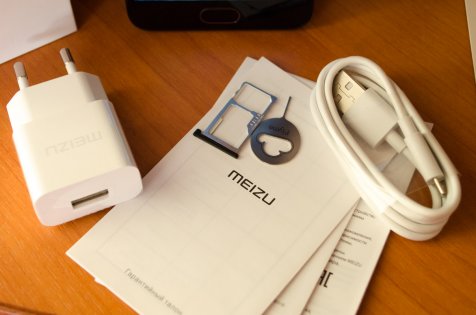

If you are already familiar with Meizu products, from our reviews or from personal experience, unboxing this smartphone will not be a revelation for you. Inside: a branded "clip", packaged in separate small boxes, a charging adapter (5V 2A) and a USB-MicroUSB cable, plus an envelope with documentation.
Appearance
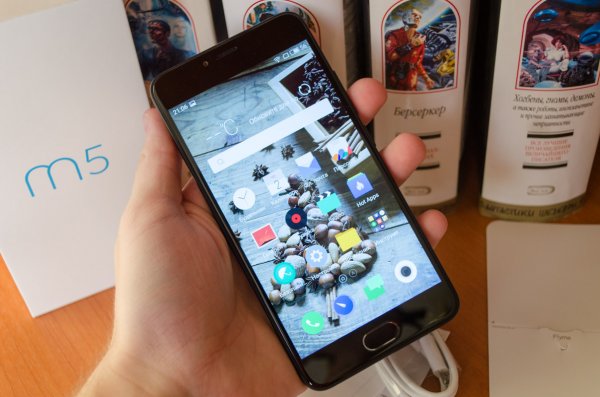
Meizu M5 received a set of various colors. The assortment of stores includes smartphones with cases of black, white, blue, mint, gold. Trashbox got the most modest version of Meizu M5 - black with 16 GB of internal memory and 2 GB of RAM.

The monoblock is enclosed in a plastic case, but a cover that covers the edges of the smartphone, a slot for cards cut into the left mobile operators and two small screws on the sides of the MicroUSB connector at the bottom end - all these industrial design details are inherent in expensive metal smartphones... In addition, the Meizu M5 has another uncharacteristic detail for the price segment - a mechanical button with a built-in mTouch 2.1 fingerprint sensor.

During the design, important details were not forgotten, such as proximity and lighting sensors, an LED event indicator, a 3.5 mm connector on the bottom edge of the device. But no matter how we looked, we did not find a second microphone for noise canceling.
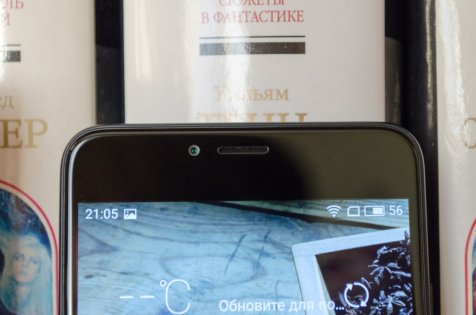
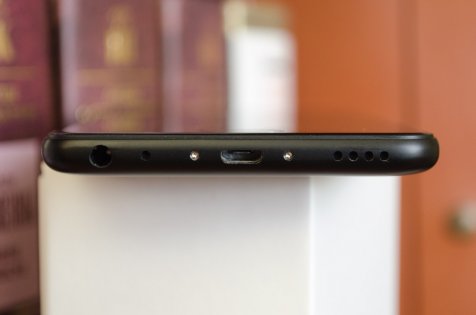
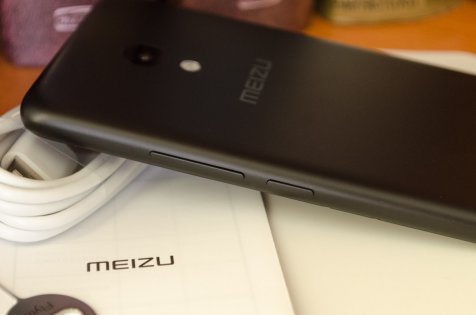
The build quality of the smartphone is high, only the SIM-card tray of our sample “walks” a little in its place. The exterior is noticeably damaged only by the soiled black plastic. We assume that other smartphone colors are free from this drawback.
Display

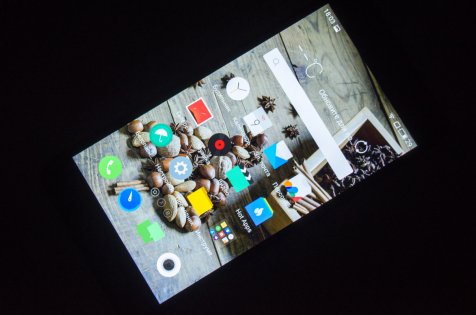

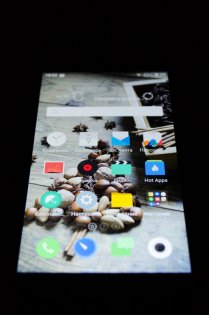


I also want to praise the backlight with a brightness of 380 cd / m2. Slight unevenness in black can be captured only in photographs with long exposure, and not at all to find fault with the white field. We also emphasize that, unlike the version of the smartphone intended for the Chinese market, our sample recognizes ten simultaneous touches to the screen.
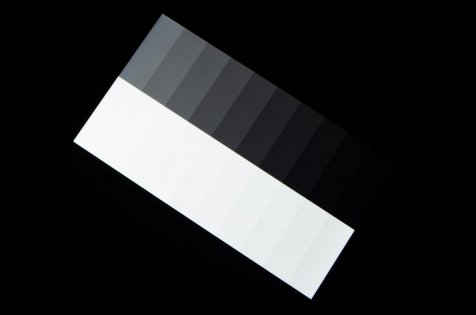


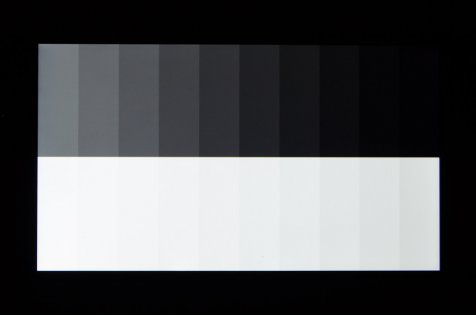
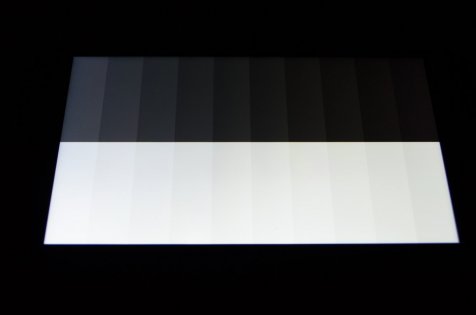



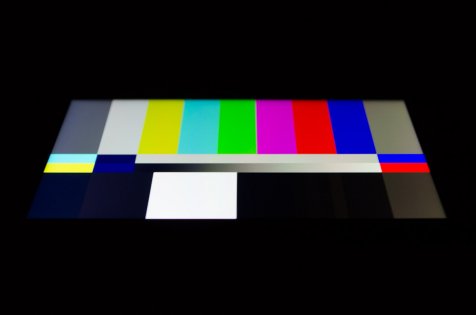
Safety glass the smartphone is slightly curved, but the 2.5D effect is offset by the plastic frame into which the screen is recessed. It is she who is felt to the touch, and not a pleasant rounding. There was no place for the anti-glare filter between the touchscreen and the protective glass, which is a pity, in the summer it would be useful.
Iron
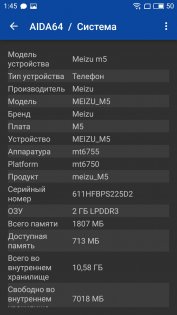



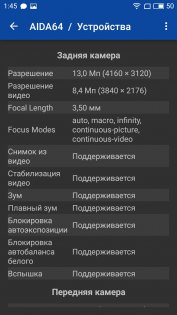
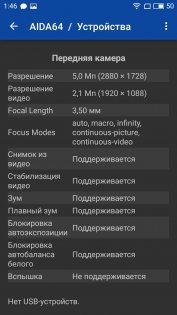
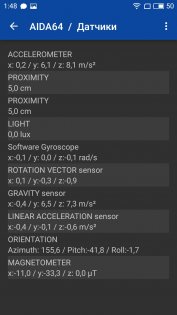

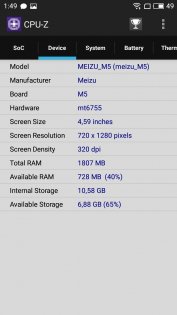

The Meizu M5 is a one-to-one hardware platform that we tested at the end of last year. Mediatek MT6750 Octa Core 2GB random access memory, 16 GB permanent (of which 14 and a half are available to the user), support for memory cards up to 128 GB.
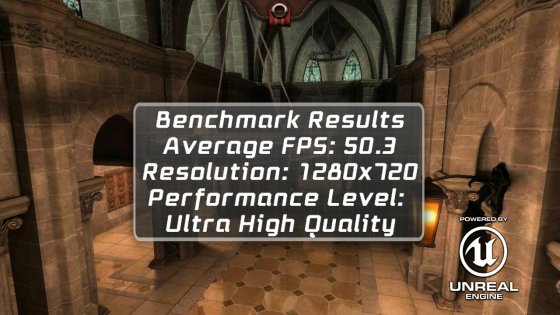
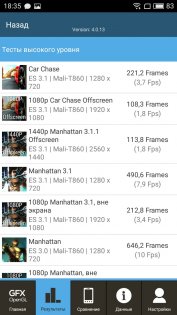


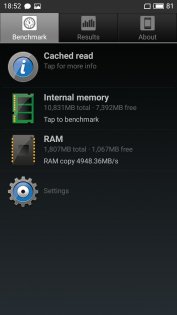
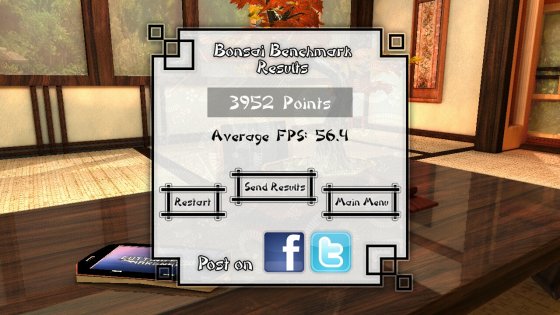

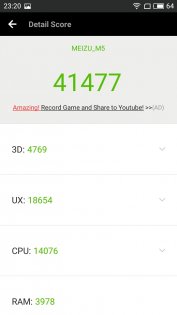



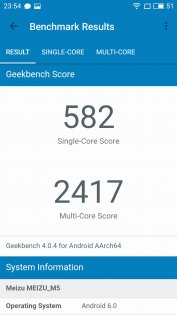
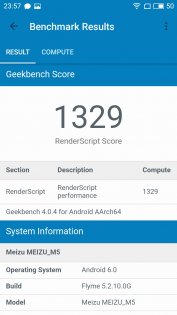

As our regular readers may remember, this configuration has shown good results, both in office applications and in mobile games... Mediatek MT6750 did not disappoint this time either.

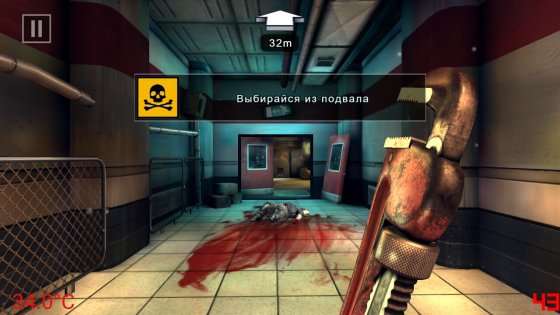

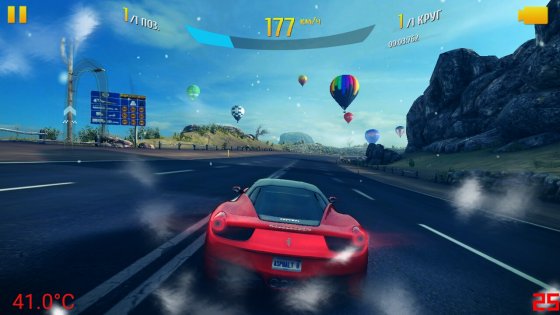


Android is responsive, and the games in our test suite demonstrate, albeit not the maximum, but stable frame rate, sufficient for playing dynamic projects.
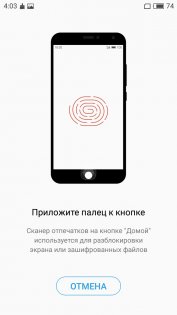

The mTouch 2.1 fingerprint sensor, on the ability of which to recognize gestures, all navigation in Flyme is based, works correctly for Meizu M5. Contrary to fears, the recognition speed is no less than that of the company's older models. Moreover, it is possible to protect using bio-identification not only the lock screen, but also individual applications.
Software
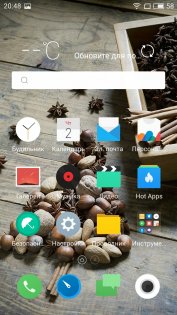
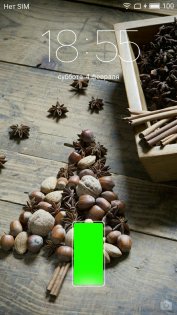
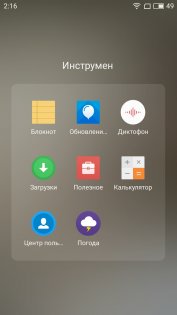
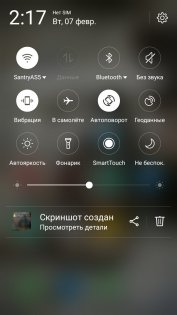
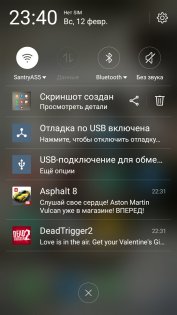



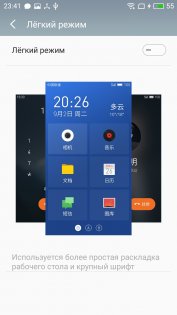
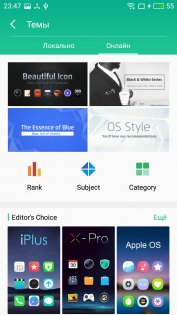
The firmware loaded into the Meizu M5 at the factory is based on Android 6.0. and has its own name - Flyme OS. If we saw version 5.2.3 of Meizu U10, then the software of Meizu M5 is a little older - 5.2.1. Last update security system dates back to December 2016. Software is relevant and will remain so thanks to updates coming "by air" for a long time to come.

Meizu's new policy regarding Google services preinstalled applications and this time. Instead of the usual directory Google play, you will first come across a store Meizu apps... Fortunately, the manufacturer did not create any special difficulties with the installation of the usual set of Google services. The installation package is available in the Hot Apps listings.










The device memory is preinstalled free games, if necessary, in an additional place, they can be easily removed by standard firmware tools, which, by the way, is still just as convenient and multifunctional.







One gets the impression that during its development, first of all, they thought about those users who do not understand the nuances of the functioning of Android, and tried to provide everything that might be needed immediately "out of the box". All sorts of small improvements complement the setup menu of the device. Is the phone owner afraid of viruses? You don't need to install anything, let alone buy - an antivirus is built into the security center. Does the user feel that too many applications are consuming RAM? An "accelerator" is provided for him here. And it doesn't matter that, in fact, both are placebos, the main thing is not to look for third-party solutions that can harm the autonomy of the smartphone much more than built-in ones and, for example, disrupt the normal receipt of notifications.
Connection
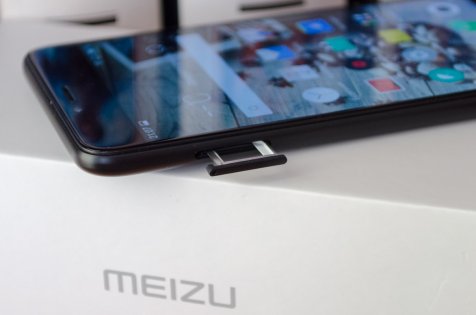
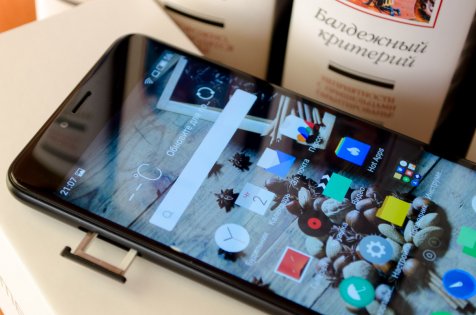
In terms of a set of frequency ranges, Meizu M5 surpasses many Chinese devices due to the support for band 20 LTE. All else being equal, high speed internet this smartphone will be more stable.

If you refuse additional memory, the slot will fit 2 nanoSIM cards. With them, the M5 demonstrates high quality voice communication, but the only microphone is sensitive to extraneous sounds and it's hard to talk on the Meizu M5 in the metro, near highways and in other noisy places. In addition, the main speaker lacks volume, and in such conditions an incoming call is easy to miss.


The rest of the communication protocols are implemented in the best possible way. Energy-saving version Bluetooth 4.0, Wi-Fi 802. At 2.4 and 5 GHz, support for connecting flash drives via USB-OTG. Accurate GPS and GLONASS navigation.
Battery

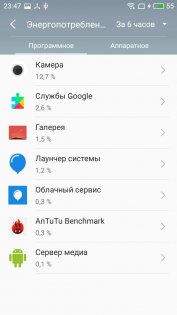
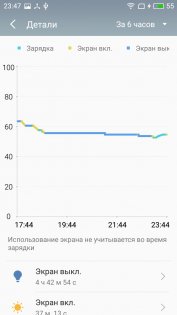





As usual, when dealing with Meizu, additional time had to be devoted to measuring autonomy. Flyme OS offers a choice of three power saving modes. They have proven to be effective in past reviews, but not this time. Meizu M5 in the editorial test of autonomy showed conflicting results.
Battery editorial test results:
LG X-Power
Samsung A7 (2017)
Xiaomi Mi6
Huawei P10
Meizu M3s mini
Xiaomi Mi 5s
Xiaomi Redmi 3 Pro
Samsung Galaxy Note 8
BQ Aquaris U Plus
Meizu M5c
Meizu PRO 6 Plus
Meizu M5
ASUS ZenFone 3 (ZE520KL)
ASUS ZenFone 3 Laser (ZC551KL)
Huawei Honor 5A
Samsung Galaxy S6
Huawei P9 Plus
With a battery capacity of 3070 mAh in the most economical of the modes, the smartphone worked for 7 hours 21 minutes, in the balanced mode - 7 hours 58 minutes, and in the productive mode - 7 hours 48 minutes.



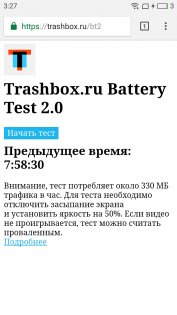


The current firmware version definitely does not reveal the potential of the battery. Meizu U10, which has a similar hardware filling and the same declared screen brightness, with a battery volume of 2760 mAh, worked in a balanced mode for 7 hours 42 minutes, and in an energy-saving mode - all 8 hours.
Camera

13 MP with f / 2.2 aperture, phase detection autofocus, dual LED flash, 4x digital zoom, as well as 5 MP front camera with ƒ / 2.0 aperture - it seems that these cameras put on a good half of the budget smartphones Meizu, moreover, each time it turns out that in some aspect the cameras are not debugged.
















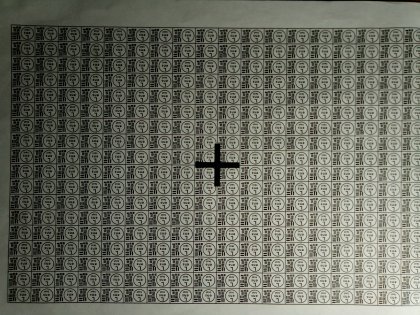
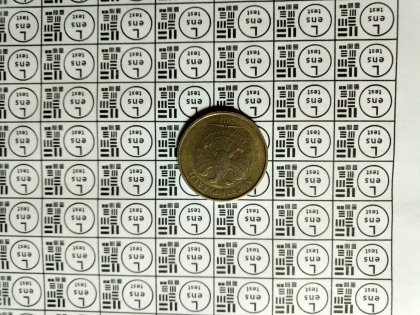

In the case of the main camera of Meizu M5, blurred zones at the edges of the frame became a characteristic problem. The blur is clearly visible on the crop, and, apparently, you have to put up with it. Otherwise, the photographic capabilities of the smartphone are unremarkable and do not stand out from the competition. You can easily get an idea of these by looking at the examples in the gallery.


The Meizu M5 is by no means revolutionary, but this smartphone is the next step forward in the evolution of the company's line of budget devices. When choosing a practical and inexpensive device for everyday use, it would be wrong to ignore it.
TO strengths smartphone, we will include support for dual-band WI-FI, accurate and fast work navigation, screen, mTouch 2.1 fingerprint sensor, and a well-matched hardware platform.
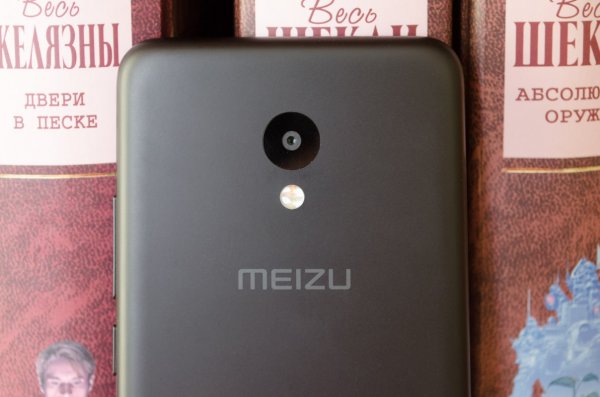
The disadvantages revealed during testing are not critical for a smartphone of this class, but they cannot be ignored. The main camera Meizu The M5 is hardly suitable for artistic purposes, and the blur zones at the edges of the frame, once you pay attention to them, begin to "catch the eye."
Power saving modes are one of the significant advantages of Flyme OS, this time they did not meet expectations and turned out to be ineffective. All that remains is to hope for future updates. If it is hardly possible to improve the quality of photos in them, then Meizu is obliged to establish energy saving.
Pros:
- MTouch 2.1 fingerprint scanner;
- Oleophobic coating and overall screen quality;
- Decent graphics performance.
- No noise canceling microphone;
- The cameras are unremarkable, the front one has blur zones along the edges.
- Battery life is less than expected;
- In the black version, the case is easily soiled.
Historically, there has been such a situation that on Russian market the maximum sales are for smartphones of the lower price range (costing less than 10 thousand rubles), in which Meizu products were not presented until recently. The company decided to rectify the situation and released a really budget M5c device. At the very beginning of the summer, the manufacturer announced the start of sales in Russia of this most affordable of its products - a smartphone with a price of 8,990 rubles, detailed review which we are presenting today.
Main characteristics of Meizu M5c (Model M710H)
- SoC MediaTek MT6737, 4 cores ARM Cortex-A53 @ 1.25 GHz
- GPU Mali-T720
- Operating room Android system 6.0
- 5 ″ IPS touchscreen display, 1280 × 720, 293 ppi
- Random access memory (RAM) 2 GB, inner memory 16 GB
- Nano-SIM support (2 pcs.)
- MicroSD support up to 128GB
- GSM / GPRS / EDGE networks (900/1800/1900 MHz)
- WCDMA / HSPA + networks (900/1900/2100 MHz)
- LTE networks Cat.6 FDD (B1 / 3/5/7/8/20), TD (B38 / 40)
- Wi-Fi 802.11b / g / n (2.4 GHz)
- Bluetooth 4.1 BLE
- GPS, A-GPS
- Micro-USB, USB OTG
- Main camera 8 MP, f / 2.0, autofocus, video 1080p
- Front camera 5 MP, f / 2.2, fixed. focus
- Proximity sensor, lighting, magnetic field, gyroscope
- Battery 3000 mAh
- Dimensions 144 x 71 x 8.3 mm
- Weight 135 g
Contents of delivery
Meizu M5c comes in a very small cardboard box, stylishly and concisely designed, without colors and luridness. There are several compartments inside, separated by a partition.

The kit consists of a USB cable of a rather thick cross-section, as well as a power adapter with an output current of 1.5 A and a maximum voltage of 5 V. The key for removing the cards is attached to a cardboard folder with paper documentation in Russian.

Appearance and usability
Meizu M5c looks better than most of its counterparts in the lower price range. This is the case when the manufacturer does not simplify the design by changing only the materials. The device is very similar to its older brothers in the line, only its body is made not of metal, but of plastic. Some Meizu smartphones received a similar version of the case before: for example, Meizu M2.

The design is simple and laconic, the one-piece plastic body with a flat back surface and rounded sides looks pretty and at the same time strict. In addition, it clearly looks more expensive than it is, especially in matte black.

The five-inch device can be called medium-sized by modern standards, it fits well in the hand, fits comfortably in any pocket, and due to the matte surfaces and a small mass it practically does not slip out of the hands. Nevertheless, it cannot be said that prints are not visible at all on matte plastic, this is not the case. Remain on the plastic and stains from contact with the palms, the same can be said about the front glass. The smartphone will have to be wiped from time to time to make it look presentable.
 |
M5c differs from its older relatives by the absence of some elements. Here, for example, there is no fingerprint scanner, there is no second microphone for the operation of the noise reduction system. Two rows of holes are cut in the bottom end, although there is, of course, only one speaker here. The universal Micro-USB connector located in the middle of this end supports connecting external devices to USB mode OTG, however, it works, for some reason, not with all flash drives.

The upper end contains only a 3.5 mm audio output for headphones, there is no additional microphone for the noise canceling system.

SIM cards are inserted into the side hybrid slot. It accepts either two Nano-SIM cards or one Nano-SIM and one microSD memory card. It is curious that the device does not detect the memory card right away, there is no hot swap, you need to reboot the smartphone.

Hardware mechanical buttons are installed on the other side. The keys are large, harsh, the response is clear, and are easy to touch.

The front panel is covered with a flat protective glass, there is no 2.5D effect here. Sensors and a peephole are traditionally installed above the screen. front camera without a flash of its own. There is also an LED event indicator that shines with a soft milky light.

Under the screen, as standard for Meizu, there is one oval-shaped hardware key. True, it does not include a fingerprint scanner, like many modern models, including Meizu devices. But the button still contains a touch pad, with which you can use gestures to perform functions that are usually assigned to two adjacent buttons, which Meizu smartphones traditionally do not have: touching the button performs the "Back" action, pressing - "Home", with a long hold you can extinguish screen.

On the back there is a camera module with a dual flash, nothing else on the back of the Meizu M5c.

At the time of the start of sales, only a version of the smartphone in a black matte case was available. A little later, red, blue, pink and gold variants should also appear on sale.

Screen
Meizu M5c is equipped with an IPS display with physical dimensions of 62 × 110 mm with a diagonal of 5 inches. The resolution is 1280 × 720, the dot density is about 293 ppi. The frame around the screen is about 4 mm wide at the sides, 15 mm at the top and bottom.
The brightness of the display can be adjusted manually or set automatic settings based on the operation of the ambient light sensor. The AnTuTu test diagnoses support for 10 simultaneous multitouch touches.
 |
 |
Detailed expertise using measuring instruments conducted the editor of the "Monitors" and "Projectors and TV" sections Alexey Kudryavtsev... Here is his expert opinion on the screen of the test sample.
The front surface of the screen is made in the form of a glass plate with a mirror-smooth surface, resistant to scratches. Judging by the reflection of objects, the anti-glare properties of the screen are about the same as that of the Google Nexus 7 (2013) (hereinafter simply Nexus 7). For clarity, here is a photo in which a white surface is reflected in the turned off screens (on the left - Nexus 7, on the right - Meizu M5c, then they can be distinguished by their size):

The screen of the Meizu M5c is slightly lighter (the brightness according to the photos is 119 versus 113 for the Nexus 7). The doubling of reflected objects in the Meizu M5c screen is very weak, this indicates that there is no air gap between the layers of the screen (more specifically, between the outer glass and the surface of the LCD matrix) (OGS type screen - One Glass Solution). Due to the smaller number of boundaries (such as glass / air) with very different refractive indices, such screens look better in conditions of intense ambient light, but their repair in the case of cracked outer glass is much more expensive, since the entire screen has to be changed. On the outer surface of the screen there is a special oleophobic (grease-repellent) coating (better than the Nexus 7 in terms of efficiency), so fingerprints are much easier to remove, and appear at a slower rate than in the case of ordinary glass.
With manual brightness control and when displaying a white field full screen the maximum brightness value was about 390 cd / m², the minimum - 4 cd / m². The maximum brightness is not high, but given the good anti-glare properties, even on a sunny day outdoors, you will be able to make out something on the screen. In complete darkness, the brightness can be lowered to a comfortable value. In the presence of automatic brightness control by the light sensor (it is located to the right of the front speaker slot). V automatic mode when the ambient light conditions change, the screen brightness both increases and decreases. This function depends on the position of the brightness adjustment slider. If it is 100%, then in complete darkness, the auto brightness function reduces the brightness to 13 cd / m2 (normal), in an office lit with artificial light (about 550 lx) sets to 190 cd / m2 (suitable), in a very bright environment (corresponds illumination on a clear day outdoors, but without direct sunlight - 20,000 lux or a little more), the brightness rises to 390 cd / m² (to the maximum - this is what you need); if the adjustment is about 50%, then the values are as follows: 4, 130 and 390 cd / m² (the first value is underestimated), the regulator by 0% - 4, 25 and 390 cd / m² (already the first two values are underestimated, which is logical). It turns out that the automatic brightness control function works adequately and to some extent allows the user to customize his work for individual requirements. At any brightness level, there is no significant backlight modulation, so there is no screen flickering either.
This smartphone uses an IPS-type matrix. The micrographs show the typical IPS subpixel structure:

For comparison, you can see the gallery of photomicrographs of screens used in mobile technology.
The screen has good viewing angles without a significant color shift even with large gaze deviations from the perpendicular to the screen and without inverting (except for the darkest when deviating along one diagonal) shades. For comparison, we present photographs in which the same images are displayed on the screens of Meizu M5c and Nexus 7, while the brightness of the screens was initially set to about 200 cd / m², and the color balance on the camera was forcibly switched to 6500 K.
White field perpendicular to screens:

Note the good uniformity of brightness and color tone of the white field.
And the test picture:

The colors on the Meizu M5c's screen have natural saturation, the color balance of the Nexus 7 and the tested screen is noticeably different.
Now at an angle of approximately 45 degrees to the plane and to the side of the screen:

It can be seen that the colors have not changed much for both screens, the contrast has decreased, but also not very much.
And white box:

The brightness at an angle of the screens has decreased (at least 5 times, based on the difference in exposure), but the Meizu M5c has a slightly lighter screen. The black field, when deviated along the diagonal, does not lighten very much and acquires a purple or reddish tint. The photos below demonstrate this (the brightness of the white areas in the direction perpendicular to the plane of the screens is the same!):

And from a different angle:

When viewed from a perpendicular view, the uniformity of the black field is poor:

Contrast (approximately in the center of the screen) is normal - about 800: 1. The response time for the transition black-white-black is 29 ms (16 ms on + 13 ms off). The transition between gray tones of 25% and 75% (based on the numerical value of the color) and back takes 43 ms in total. The gamma curve, plotted using 32 points with equal intervals in terms of the numerical value of the shade of gray, did not reveal a blockage in either the highlights or the shadows. The exponent of the approximating power function is 2.49, which is higher than the standard value of 2.2. In this case, the real gamma curve strongly deviates from the power dependence:

This device has an aggressive dynamic adjustment of the backlight brightness in accordance with the nature of the displayed image - the brightness of the backlight decreases in dark images in the middle. As a result, the obtained dependence of brightness on hue (gamma curve) does not correspond to the gamma curve static image, since the measurements were carried out with sequential output of shades of gray almost on the entire screen. For this reason, a number of tests - determining the contrast and response time, comparing the black illumination at angles - we carried out (however, as always) when displaying special templates with a constant average brightness, and not single-color fields across the entire screen. In general, such a non-switchable brightness correction does nothing but harm, since a constant change in screen brightness can at least cause some discomfort, reduce the visibility of gradations in the shadows in the case of dark images and the readability of the screen in bright light, since the brightness of the backlight is not the brightest in the average image is underestimated, and its already not an excess.
The color gamut is close to sRGB:

The spectra show that the matrix filters moderately mix the components together:

As a result, colors have natural saturation and hue. The balance of shades on the gray scale is medium, since the color temperature is much higher than the standard 6500 K, but the deviation from the spectrum of the absolute black body (ΔE) is below 10, which is considered an acceptable indicator for a consumer device. At the same time, the color temperature and ΔE vary little from shade to shade - this has a positive effect on the visual assessment of the color balance. (The darkest areas of the grayscale can be ignored, since there is no color balance. of great importance, and the error in measuring color characteristics at low brightness is large.)


This device has the ability to correct the color balance by adjusting the hue.

However, after correction, the white point hardly changes, and the color temperature and ΔE change very much. It looks disgusting, so it makes no sense to perform the correction.
To summarize: the screen has a low maximum brightness, but has good anti-glare properties, so the device can somehow be used outdoors even on a sunny summer day. In complete darkness, the brightness can be lowered to a comfortable level. It is also acceptable to use the mode with automatic brightness adjustment, which works adequately. The advantages of the screen include an effective oleophobic coating, no air gap in the layers of the screen and no flicker, as well as sRGB color gamut. Among the significant drawbacks, we attribute the poor uniformity of the black field, as well as the non-switchable dynamic adjustment of the backlight brightness. Taking into account the importance of characteristics for this particular class of devices, the screen quality can be considered relatively high.
Camera
The front module of the Meizu M5c received a 5-megapixel sensor and a four-component lens with an f / 2.2 aperture, with a fixed focus and without its own flash. Naturally, there is a portrait decoration mode with several levels of adjustment, and there is also manual mode with adjustments for photosensitivity, white balance, contrast, saturation, exposure compensation. With all this, the selfie camera shoots rather weakly: there are areas of blur even in the central part of the frame, the detail is generally low, which is why the image is friable. Dynamic range is narrow, so there are overexposures and underexposed areas in one image.

The main camera uses a module with an 8-megapixel sensor, a four-component lens with an aperture of f / 2.0, there is a quite nimble phase detection autofocus and a dual, but not very bright flash. There is no stabilization system.
As usual, in the settings there is a manual mode for controlling the camera settings. If you turn it on, a setting slider appears, the same as for a selfie camera, with variable values for sensitivity (up to ISO 1600), exposure compensation, saturation and contrast, as well as white balance. There are few additional modes: a QR code scanner, panorama, animated GIF, there is HDR.
 |
 |
 |
 |
 |
 |
The camera can shoot video in a maximum resolution of only 720p, not only 4K video is not supported, but also Full HD. There is no stabilization function, a slight tremor of the hands is noticeable even in static shooting, but to say nothing of movement. The picture itself is juicy, bright, but there is no need to expect high details at this resolution. There are no complaints about sound recording, the sound is of high quality, without noticeable distortions, but apparently there is no noise reduction system here.
- Movie number 1
- Movie # 2 (18 MB, 1280 × [email protected] fps, H.264, AAC)
The camera can be called good. Despite the fact that unprocessed noises are visible in some places, details are not lost even in the distant shots, although there they are "tightened" programmatically. Sharpness is well maintained across the frame. As a result, the camera can be safely recommended for documentary photography.
Telephone part and communications
The communication capabilities of Meizu M5c include support for LTE Cat.4 (up to 150 Mbps), a number of LTE FDD and TDD frequency bands are supported, including all 3 FDD LTE bands of interest to us (band 3, 7, 20). The device behaves confidently in the city limits of the Moscow region, the quality of signal reception raises no objections.
At the same time, only one Wi-Fi band (2.4 GHz) is supported, NFC is not. You can standardly organize a wireless access point via Wi-Fi or Bluetooth 4.1 channels. Connector USB Type-C supports connecting external devices in USB OTG mode. The navigation module only works with GPS (with A-GPS). The first satellites during a cold start are detected within the first tens of seconds, the positioning accuracy is not bad. There is a built-in magnetic field sensor.
 |
 |
The phone app supports Smart Dial. In the contacts section, there are many settings for importing and grouping, but the settings for displaying a contact (last name, first name, other data) for incoming call absent altogether.
 |
 |
 |
 |
The smartphone does not support both 3G / 4G SIM cards in active standby mode at the same time. That is, when one card is assigned for data transmission in 4G, the second can only work in 2G. The interface does not allow you to select a specific SIM card for voice calls and SMS in advance - only during connection; the card can be specified in advance only for data transmission. Cards work in Dual mode SIM Dual Standby, there is only one radio modem.
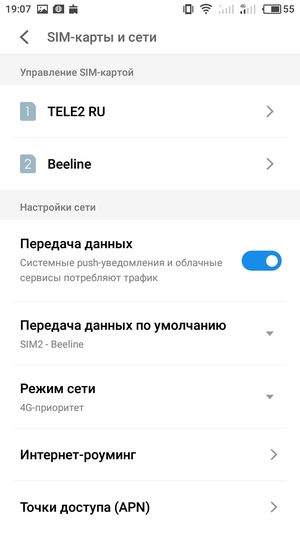 |
 |
Software and multimedia
As software platform used by google Android version 6.0 s proprietary shell Flyme OS. The interface is nice, in new version it looks even better, all interface and application icons have been redrawn, new animation options have appeared, themes have been added.
But, unfortunately, the time of maximum brevity of Flyme OS has passed irrevocably. Now it will not be possible to say that the new Meizu smartphone does not have a lot of junk pre-installed programs. With the advent of the Hot Apps section, they are installed by default, there are many of them, there is even a separate folder with demo games that you need to buy for full use. Sberbank and Yandex applications have appeared, and you will not be able to refuse their initial download - you can only delete all this one by one manually. In the same time, google apps(gapps), including the Play Store, will have to be installed manually - initially, Meizu smartphones no longer have them. An alternative keyboard TouchPal is preinstalled, which has a lot of additional features.
 |
 |
 |
 |
 |
 |
To listen to music, we use our own proprietary audio player with the usual set of settings in the form of preset equalizer values, which can only be used with connected headphones. Both in headphones and through the loudspeaker the device sounds average: the sound is clear, without impurities, the volume margin is not excessive, high frequencies prevail. There is no FM radio in the smartphone. The microphone demonstrates satisfactory sensitivity, the voice recorder is quite suitable for recording lectures.
 |
 |
 |
 |
Performance
The Meizu M5c hardware platform is based on the MediaTek MT6737 SoC, made according to the 28 nm process technology. The 64-bit platform configuration includes 4 Cortex-A53 processor cores operating at frequencies up to 1.25 GHz. The Mali-T720 video accelerator is responsible for graphics processing. RAM is 2 GB and user storage is 16 GB. Of these, in reality, less than 1 GB of RAM is free and only about 10.7 of ROM. Expandable memory by installing microSD cards there is, but applications cannot be installed on it. It is also possible to connect external flash drives in USB OTG mode.
 |
 |
 |
 |
MediaTek MT6737 is one of the simplest in terms of capabilities of modern platforms for entry-level mobile devices, it is focused on the ultra-budget class of devices. You should not expect high performance indicators from such a platform, the hero of the review demonstrates only about 29K points in AnTuTu. The hardware capabilities of the review hero are minimal, the smartphone shows in all tests low level... Here, not only demanding games slow down noticeably and graphic tests such as Mortal Kombat X and Epic Citadel, but sometimes there are delays even when flipping through desktops and opening applications. Such a device definitely does not have a reserve for the future.


Benchmarking AnTuTu and GeekBench:
All the results obtained by us when testing the smartphone in the most recent versions of popular benchmarks, we have summarized in tables for convenience. Several other devices from various segments are usually added to the table, also tested on similar latest versions of benchmarks (this is done only for a visual assessment of the obtained dry numbers). Unfortunately, within the framework of one comparison, it is impossible to present the results from different versions of benchmarks, therefore, many worthy and relevant models remain "behind the scenes" - due to the fact that they once passed the "obstacle course" on previous versions test programs.
 |
 |
Testing the graphics subsystem in game tests 3DMark, GFXBenchmark and Bonsai Benchmark:
When testing in 3DMark for the highest performing smartphones, it is now possible to run the application in Unlimited mode, where the rendering resolution is fixed at 720p and VSync is disabled (which can cause the speed to rise above 60 fps).
| Meizu M5c (MediaTek (MT6737) |
Micromax Canvas Juice A1 (Qualcomm Snapdragon 210) |
Honor 6C (Qualcomm Snapdragon 435) |
Htc one X10 (MediaTek Helio P10 (MT6755)) |
Honor 8 lite (HiSilicon Kirin 655) |
|
| 3DMark Ice Storm Sling Shot ES 3.1 (more is better) |
101 | — | 254 | 421 | 398 |
| GFXBenchmark Manhattan ES 3.1 (Onscreen, fps) | 3 | — | 11 | 5 | 5 |
| GFXBenchmark Manhattan ES 3.1 (1080p Offscreen, fps) | 1 | — | 5 | 5 | 5 |
| GFXBenchmark T-Rex (Onscreen, fps) | 10 | 9 | 28 | 17 | 19 |
| GFXBenchmark T-Rex (1080p Offscreen, fps) | 6 | 5 | 16 | 17 | 18 |
 |
 |
Browser cross-platform tests:
As for benchmarks for evaluating the speed of the javascript engine, you should always make allowances for the fact that the results in them significantly depend on the browser in which they are launched, so that the comparison can be truly correct only on the same OS and browsers, and this possibility is available when testing not always. In the case of Android OS, we always try to use Google Chrome.
 |
 |

results AndroBench test on the speed of working with memory:

Thermal imagery
Below is a thermal image back surface obtained after 10 minutes of battery test in the GFXBenchmark program:

Heating is more localized in the upper part of the device, which, apparently, corresponds to the location of the SoC chip. According to the heat chamber, the maximum heating was 38 degrees (at an ambient temperature of 24 degrees), which is not very much.
Video playback
To test the "omnivorous" video playback (including support for various codecs, containers and special features, such as subtitles), we used the most common formats that make up the bulk of the content available on the Web. Note that it is important for mobile devices to have support for hardware video decoding at the chip level, since it is often impossible to process modern versions using processor cores alone. Also, don't wait from mobile device decoding everything, since the leadership in flexibility belongs to the PC, and no one is going to challenge it. All results are tabulated.
| Format | Container, video, sound | MX Video Player | Native video player |
| 1080p H.264 | MKV, H.264 1920 × 1080, 24 fps, AAC | reproduced normally | reproduced normally |
| 1080p H.264 | MKV, H.264 1920 × 1080, 24 fps, AC3 | reproduced normally | video plays fine, no sound |
| 1080p H.265 | MKV, H.265 1920 × 1080, 24 fps, AAC | the video does not play, there is sound | |
| 1080p H.265 | MKV, H.265 1920 × 1080, 24 fps, AC3 | reproduced with significant delays | video does not play, there is no sound |
Further video playback testing was done by Alexey Kudryavtsev.
We did not find the MHL interface, like Mobility DisplayPort, in this smartphone, so we had to confine ourselves to testing the output of video files on the screen of the device itself. To do this, we used a set of test files with an arrow and a rectangle moving one division per frame (see "Methodology for testing video playback and display devices. Version 1 (for mobile devices) no
Note: If both columns Uniformity and Skips green ratings are set, this means that, most likely, when watching movies, artifacts caused by uneven alternation and skipping of frames will either not be visible at all, or their number and visibility will not affect the viewing comfort. Red marks indicate possible problems related to the playback of the respective files.
According to the criterion for outputting frames, the quality of video files playback on the screen of the smartphone itself is good, since in most cases frames (or groups of frames) can (but are not required) to be displayed with more or less uniform alternation of intervals and without frame drops. The refresh rate of the screen is 58 Hz, so in the case of files with 60 fps, at least two frames per second are skipped, but sometimes more, and several in a row. When playing video files with a resolution of 1280 by 720 pixels (720p) on a smartphone screen, the image of the video file itself is displayed exactly along the edge of the screen, one to one pixel by pixel, that is, in the original resolution. The brightness range displayed on the screen corresponds to the standard range of 16-235: in shadows and highlights, only about a couple of shades merge with black and white, respectively.
Battery life
Fixed accumulator battery installed in Meizu M5c has a capacity of 3000 mAh. With such a battery, the hero of the review demonstrates modest but satisfactory autonomy results. In real operating scenarios, the charge is enough for half a day or a day, depending on the load, but you should not count on more for sure.
The tests were traditionally carried out at the usual level of power consumption without using power saving functions, although these, of course, are provided in the device.
Continuous reading in the Moon + Reader program (with a standard, light theme) at a minimum comfortable brightness level (the brightness was set to 100 cd / m2) with auto-scrolling lasted about 14 hours until the battery was fully discharged, and with continuous video viewing in high quality (720p) with the same brightness level through Wi-Fi network the device operates for about 9 hours. In 3D games mode, the smartphone can work up to 5.5 hours.
From a standard power adapter with a maximum output current of 1.5 A, the smartphone charges for 3 hours with a current of 1.28 A at a voltage of 5 V. Wireless charging the smartphone does not support.
Outcome
The Meizu M5c smartphone is pretty simple in all respects. Low screen resolution, very weak hardware platform, lack of a fingerprint scanner, NFC, H.265 codec support and satellite systems Glonass and BeiDou, as well as a modest level of autonomy and the presence of a large number of pre-installed garbage useless applications, including demo games - all this is not very happy. On the other hand, Meizu products traditionally boast high workmanship, no obvious defects, and imperfections. Everything stated is in place, there are no shortcomings. For a certified smartphone at the price of 8990 rubles in Russian retail, this product is quite suitable, but you need to understand that this is typical “ workhorse”, Not a versatile multimedia entertainment device. For them, the Meizu M5c does not have enough strength and capabilities.
Budget Race Chinese smartphones continues, and today we will tell about one of its participants.
Meizu M5 was officially presented on October 31, 2016, the smartphone can be called the successor to Meizu M3. The novelty has received improved hardware, some design changes and a proprietary button-fingerprint mTouch 2.1. We will tell you about everything in order in the review of the gadget.
Specifications and equipment
- Processor: 8-core MediaTek MT6750 clock frequency 1.5 GHz.
- Graphics controller: Mali-T860.
- Display: 5.2 inches, 1280 × 720 pixels, 282 ppi, IPS, GFF, 2.5D glass.
- RAM: 2/3 GB LPDDR3.
- Built-in memory: 16/32 GB (with support for microSD-cards up to 128 GB)
- Main camera resolution: 13 megapixels (f / 2.2, dual-tone LED flash, phase detection autofocus).
- Front camera resolution: 5 MP (f / 2.0).
- Battery: built-in, capacity 3070 mAh.
- Platform: Android 6.0 Marshmallow with Flyme 5.2 proprietary firmware.
- Interfaces: LTE 4G with VoLTE, Wi-Fi 802.11, Bluetooth 4.0 LE, GPS, GLONASS, OTG, USB HOST.
- MTouch 2.1 Fingerprint Scanner.
- 3.5mm headphone jack.
- Dimensions: 147.2 x 72.8 x 8mm.
- Weight: 138 grams.
Meizu M5 is sold in a regular cardboard box, inside you can find a white 1.5A power supply with a Chinese plug, a white charging cord, a branded clip for removing the SIM card tray, protective film to the display and documentation.
We bought Meizu M5 on AliExpress. The seller via the link sent the smartphone as quickly as possible, and put an adapter for charging and a silicone case as a gift. The smartphone arrived in Rostov-on-Don in just 3 weeks.
Design and ergonomics
Meizu M5 is a plastic case in the manufacturer's trademark and familiar design. The smartphone is available in five colors: black, white, navy blue, green and gold. We have a black version with a matte back cover.

The front panel of the device is absolutely standard - above the screen there is a hole for the earpiece, a proximity sensor and an LED indicator that notifies you of missed calls and notifications.

Below the display is an mTouch 2.1 button with a built-in fingerprint finger, as on all modern smartphones manufacturer.

The rear panel placed the main camera and LED flash flush with the common surface. Below is the Meizu logo. On the black color option, the camera module is almost invisible, as are the trademarks at the bottom of the back.

The power and volume buttons are located on the right side edge in a familiar and convenient position. They are plastic and are pressed without discomfort, do not stagger or dangle.


On the left you can find a slot for a SIM card and memory card, which can be removed with a special paper clip.


There is nothing on the top edge, on the bottom are the perforations of the main speaker, a microUSB connector for charging, a 3.5mm headphone jack and a small hole for a noise canceling microphone.

The ergonomics of the device can be positively characterized. The plastic back cover is rounded at the edges, so it is very convenient to hold the Meizu M5 in your hands. The materials are not easily soiled, not slippery and durable to the touch. No extraneous noise or backlash was detected when using the gadget, it is pleasant to hold the device in your hand.

Display and picture
The Meizu M5 is equipped with a 5.2-inch IPS display with a resolution of 1280 x 720 pixels and a pixel density of 282 ppi. The display is covered with a protective 2.5D glass, the oleophobic coating does its job well.

The screen is quite high-quality, many Meizu smartphones are famous for this, but HD-resolution is not enough for a 5.2-inch diagonal. We also note the lack of contrast of the picture, sometimes it seems that there are simply not enough colors.

In the screen settings, there is a color temperature adjustment and an eye protection mode.


Performance and benchmarks
Meizu M5 is powered by a budget 8-core MediaTek MT6750 processor clocked at 1.5 GHz. It is this chipset that is used in the Meizu M3 and Meizu U10. The Mali-T860 controller is responsible for graphics processing, the amount of RAM is 2 GB (there is a 3 GB version), physical memory is 16 GB (there is a 32 GB version).

Ensuring smoothness and high speed the smartphone does an excellent job of the interface. All internal functions work smartly and without delay, with a large number of open background applications, no problems were found.
Of course, demanding high performance from a budget $ 100 smartphone is unwise. It copes with simple games without problems, however, when 3D graphics and other "bells and whistles" appear, slowdowns will be noticeable. At the same time, you can comfortably play Angry Birds 2, Subway Surfers, Clash Royale and Shadow Fight 2 on your smartphone.
Benchmark run results:




Cameras and Photos
Meizu M5 is responsible for the photographic ability of the main camera with a resolution of 12 megapixels, phase detection autofocus, f / 2.2 aperture and dual-tone LED flash. The specifications are standard for the budget segment, but these are just numbers. In fact, the camera behaves very well, sometimes producing great pictures.

The main conditions for creating a high-quality photo are a sufficient level of natural light, no rush (hover and wait for the autofocus to "focus") and the ability to take a couple of shots at once. In this case, you will be able to select the best from the received images. Here are some examples of photos in the daytime:





At night, everything is more difficult - even a professional photographer will not help to avoid noise, but why should this be surprised in a smartphone for 6500 rubles?


The camera copes with macro photography perfectly, the objects are clear and detailed.

Selfies turn out to be the most common, for social networks it should be enough.
Fingerprint interface and scanner
The smartphone runs on Android 6.0 Marshmallow and proprietary firmware Flyme OS 5.2, which is well known to all owners of Meizu smartphones. It is comfortable, customizable and stylish in its own way, but in our case the main thing is that it works smoothly and quickly - there are only positive impressions.
Taking the Meizu M5 in hand for the first time, there is a lasting déjà vu effect. Designers, having found their own corporate identity a few years ago, clearly do not seek to bring something new, preferring recognition and practicality. Other brands are also guilty of this, which ultimately led to a situation when the market was flooded with legions of monotonous models, differing from each other only in minor details. But Meizu went even further in this regard - they copy and paste their own smartphones and, as a result, holding new model, you have to make an effort to find some differences from their predecessors. M3s obviously served as a template for the M5, only the diagonal of the screen and the materials of the case were changed - the new model was dressed in plastic and painted in bright colors, based on which we can assume that the main audience for which the smartphone is targeted is young people.
There is one more important point... This is the price. The cost of the smartphone is within $ 100, which automatically makes it interesting for the majority of buyers. Such smartphones are usually taken for children, parents, that is, for undemanding users. Or as a smartphone with the main task: Internet connection. When I am asked to help pick up a smartphone in the price range under $ 100, I first of all recommend Meizu and Xiaomi smartphones. The main competitor of the Meizu M5 is the Xiaomi Redmi 4x. In fact, these are smartphones equal in price, functionality, performance and memory capacity. But at the same time, the complete opposite in design, concept and SOC (MTK vs Snapdragon). There is no clear winner in this struggle, because everyone chooses what is closer to him in spirit. And if reviews on smartphones from Xiaomi have now simply flooded the Internet, then it is already more difficult to find detailed information on Meizu. Today I will try to balance the situation by giving you an overview of the budget Meizu M5. I will try to be as objective as possible and indicate not only the advantages, but also the disadvantages, which, of course, are full in any budget-class smartphone.
Technical Meizu specifications M5
CPU: MediaTek MT6750 - 8 cores (4 Cortex A53 cores at 1.5 Ghz and 4 Cortex A53 cores at 1 Ghz)
Graphics: ARM Mali T860 MP2
RAM: 2Gb / 3Gb
Built-in memory: 16Gb / 32Gb
Display: 5.2 inches with a resolution of 1280x720, IPS.
Camera: Main - 13 MP, f 2/2, dual-LED flash. Frontal - 5 Mp, f2 / 0
Wireless interfaces: WiFi - 802.11 a / b / g / n, dual band 2.4Ghz / 5Ghz; Bluetooth 4.0; GPS + GLONASS.
Networks: 2G - GSM 850/900/1800/1900, CDMA 800; 3G - WCDMA 850/900/1900/2100, TD-SCDMA B34, B39; 4G - FDD-LTE Bands: B1 / B3 / B7, TD-LTE B38 / B39 / B40 / B41
Additionally: Button with built-in mTouch fingerprint scanner, gyroscope, compass.
Battery: 3070 mAh
Operating system: Flyme 5 on Android base 6.0
Dimensions (edit): 147.28mm x 72.8mm x 8.15mm
The weight: 138g
Simple white box with hieroglyphs and number 5. If you buy official version offline, there will be no hieroglyphs, and the power adapter will be with the correct plug (euro). This is where the differences end - in China you buy exactly the same smartphone, only $ 25 cheaper. Even the firmware is already international, global, as indicated in the product description. 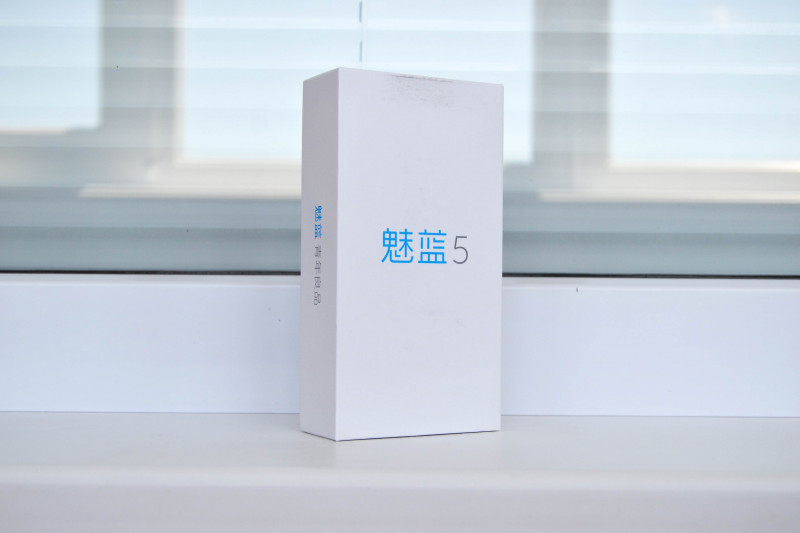
Equipment - minimum: smartphone, Charger, usb cable, company clip and user manual. The seller put the adapter for the outlet separately, there was no place for it in the box. 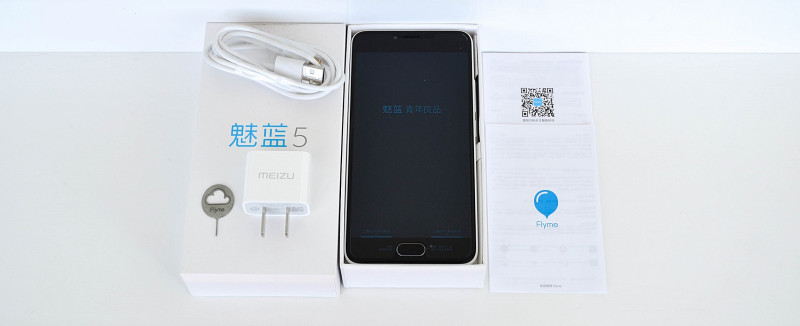
By adding $ 5, you can choose an extended set: a simple transparent silicone case and a protective glass on the screen. 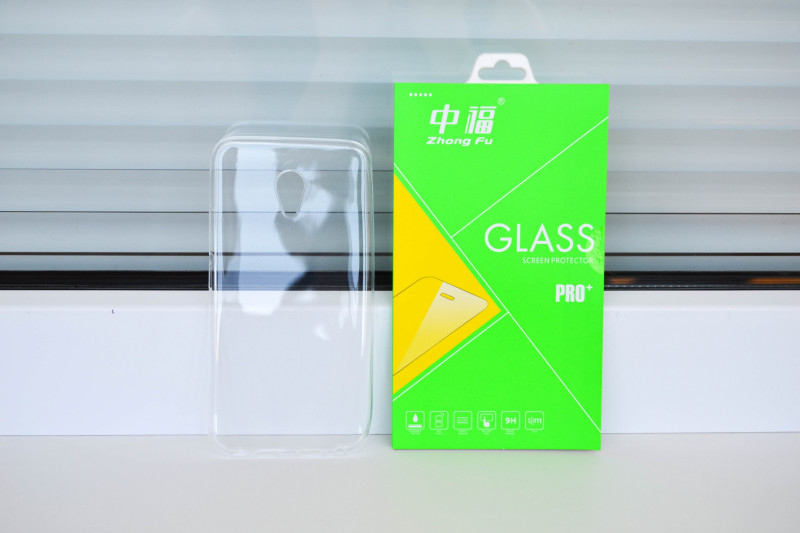
The cover is certainly the cheapest, but for those who like to “dress up” the smartphone will do for the first time. She dresses very tightly, fits the body well. The glass is dense, white (without blue tints) - it is not scratched, but there is no oleophobic coating (or it is very weak). 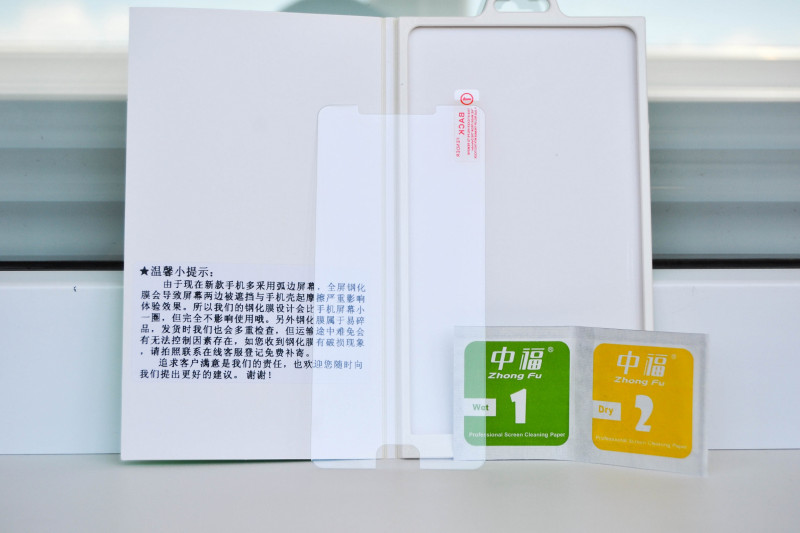
The miniature charger can charge the device with a current of up to 1.5A at a voltage of 5V. It takes about 2.5 hours to fully charge. 
Regardless of the color of the "back", the front part is always black. Classic silhouette, touch-physical button with built-in fingerprint scanner - typical design from Meizu. Nothing fancy, but it looks nice. 
The branded mTouch button is both the main feature of the Meizu smartphone and their main sore. Suffice it to recall the marriage of the button in M3s, when after some time of use it could fail. With this misunderstanding, the company badly spoiled its reputation - people massively bought buttons on aliexpress for self-repair or handed over phones under warranty (purchased offline). In Meizu M5, the situation was corrected, but the residue remained ...
On the other hand, mTouch provides tremendous convenience when using a smartphone - depending on the actions (quick or long touch, short or long press), the smartphone performs the usual actions, replacing the touch or on-screen buttons: menu, home, back. In addition, a fingerprint scanner is built into the button, which allows you to quickly unlock your smartphone, even if it is lying on the table. 
The back of the smartphone is made of plastic. Depending on the color, the material also changes. For example, a white smartphone has a glossy cover, and a completely black one has a matte cover with a soft touch coating. 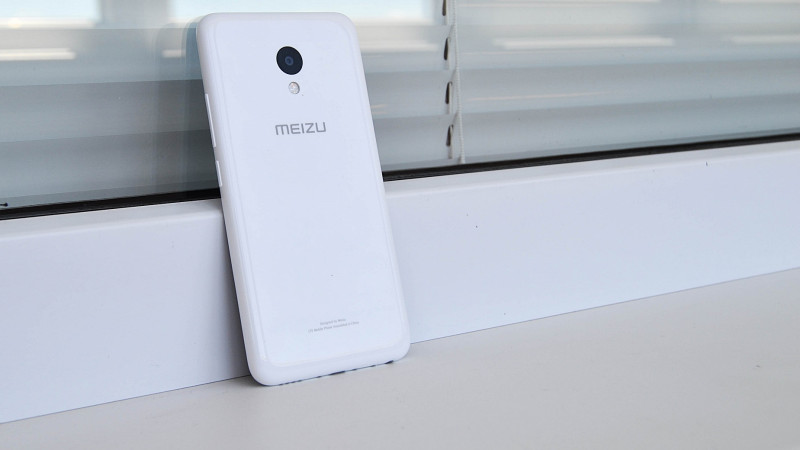
Plastic does not look as noble as the recently popular metal, but it allows you to significantly expand the color palette. In addition to the usual white and black colors, you can find gold, blue and even mint on sale, although I have not seen the latter on sale. Moreover, the price tag may differ depending on the lack of color. Surprisingly, usually the most expensive is black, at the JD store is the cheapest. On Ali, the price of a black M5 starts at $ 105. 
I think the great news is that back covers can be changed. You can find them on sale from $ 5. Thus, you do not have to bother about the covers and appearance case, periodically changing the back covers. By the way, plastic scratches quickly enough, after a week I noticed the first micro scratches, although they are visible only at a certain angle. 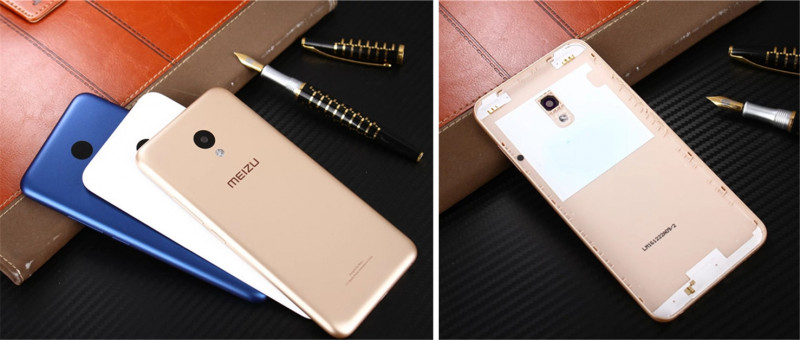
The smartphone is thin, I can't feel it in my jeans pocket. Despite the plastic case, it is not slippery. The rounded edges have a positive effect on tactile sensations, you don't want to let go of the smartphone. 
The volume and lock buttons do not dangle, they are located on the right side. 
The connector for charging, headphones, as well as an audio speaker was placed on the bottom edge. There is only one speaker - the volume is average, the quality is not bad. Unlike cheaper brands (Elephone, Doogee, etc.) at high volume it does not hit the ears with high frequencies, offering a more balanced sound with a bias towards the mids. 
The camera of the smartphone is made flush with the body, below there is a dual LED flash with different color temperatures. 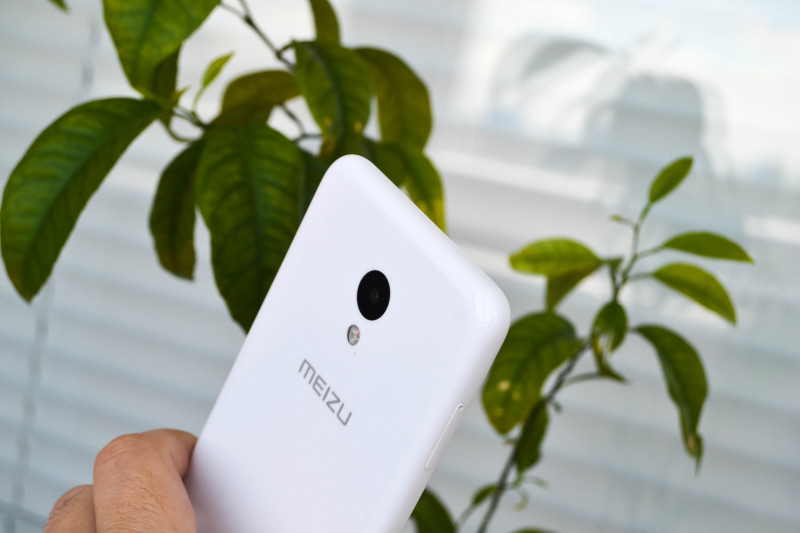
When squeezed, the case does not creak, does not play and feels solid. 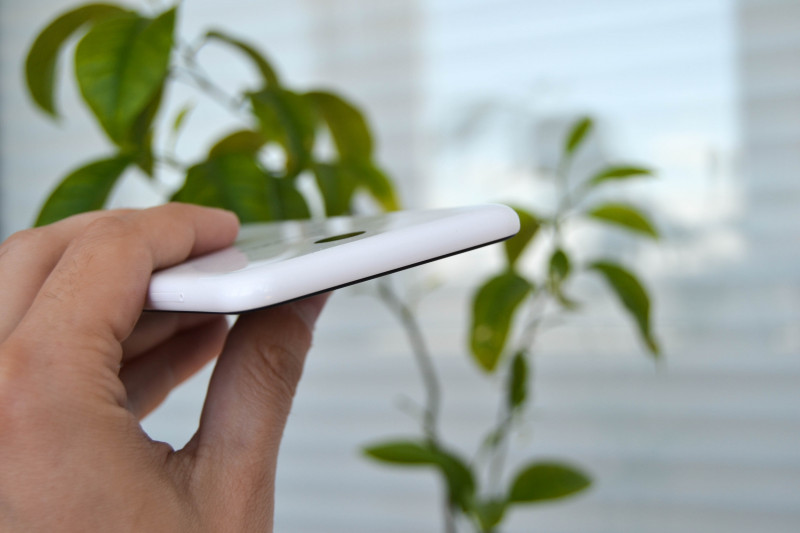
The earpiece is covered with a decorative mesh. We did not forget to bring in such a small but extremely necessary invention as an LED - an indicator of events. 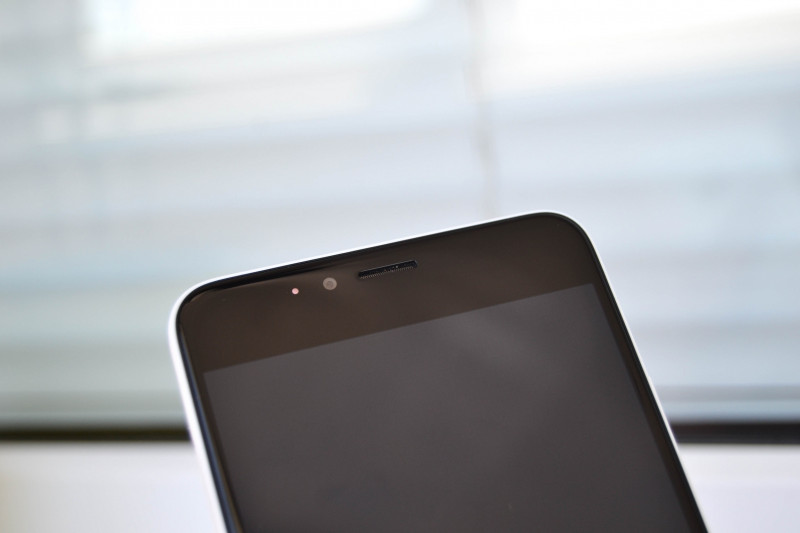
The tray with SIM cards was placed on the left side. The smartphone is equipped with a hybrid tray that can accommodate 2 sim card, or sim card + memory card. 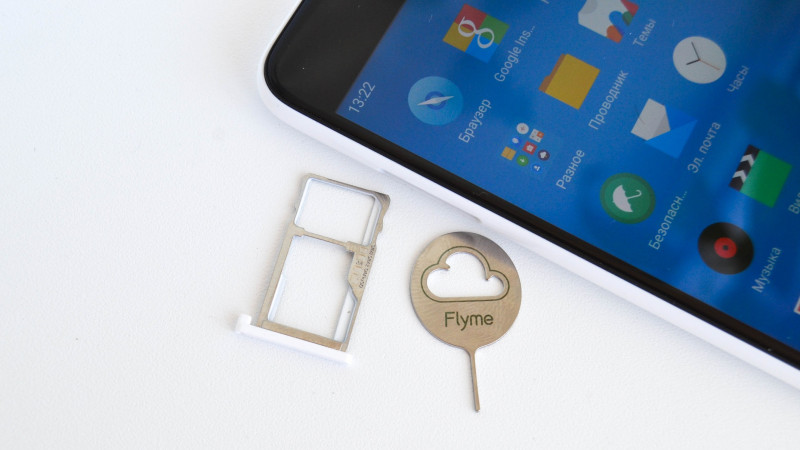
I recommend that you think very well here. The smartphone is sold in two versions: 2Gb \ 16Gb and 3Gb \ 32Gb. And if even 2Gb of RAM is enough for simple tasks, then the built-in memory is very small, especially in the 16Gb version, where about 10Gb is available to the user. A dozen applications, a few photos, a couple of videos and then you realize that the free space is running out ... In general, you can take the younger version only if you use one SIM card, and insert a memory card into the free slot (supports up to 128Gb). Or make a so-called "sandwich" from a memory card and a sim card, on the network you can find detailed instructions how to do it, even in video format. Your sandwich will look something like this: 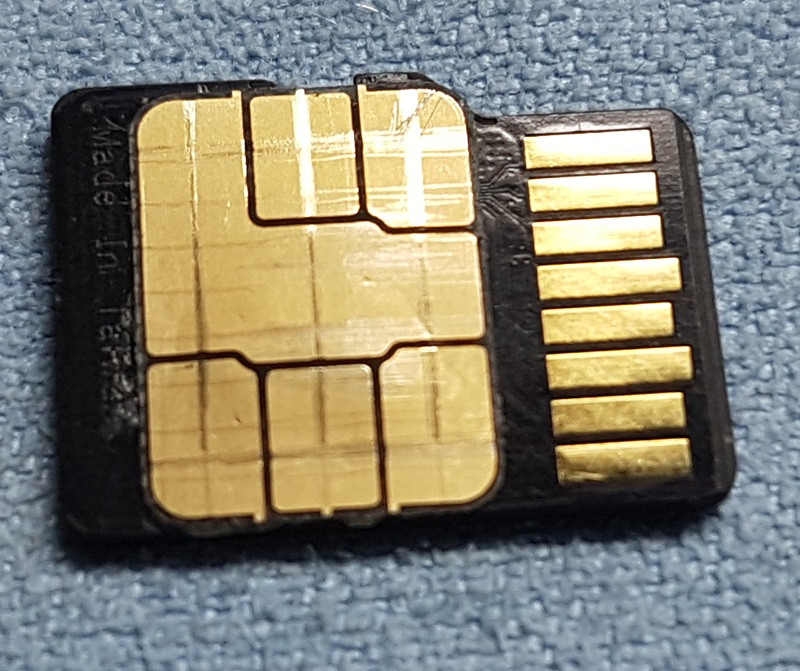
Thus, the smartphone will see both SIM cards and a memory card, it will look like this in the tray. 
This is of course a kind of "collective farm" and personally I would recommend just taking the older version - 3Gb / 32Gb, this amount of memory will already be enough for most users, plus an additional gigabyte of RAM for performance and multitasking.
Now about the display. Its diagonal is 5.2 inches, and the resolution is HD (1280x720). The resolutions are quite acceptable on such a diagonal - the pixels are indistinguishable. But the processor is much easier to process information, which has a positive effect on performance and speed. The frames around the screen are quite ordinary, thanks to the black "face" everything looks organic. 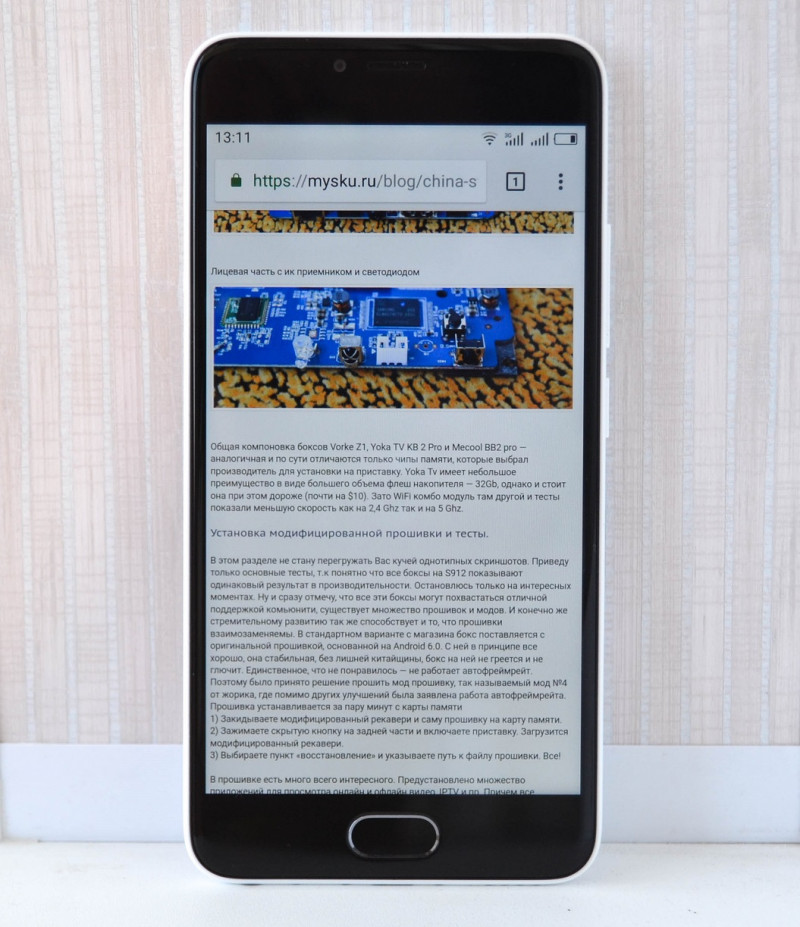
The display is made using full lamination technology, in combination with an IPS-matrix at the output, we get a pleasant picture with good viewing angles. The colors look quite natural, the black has a good depth, there are no highlights. There is not much to scold the screen of Meizu M5 for, except that the detailing is not the best, but you can only see the difference by direct comparison with more expensive models. Overall, the screen is not perfect, but good. ![]()

The screen fades in the sun, but remains readable. The maximum brightness is 380 cd / m2, the adjustment range is high, the minimum brightness allows you to read in the dark, although the xiaomi has even less brightness. 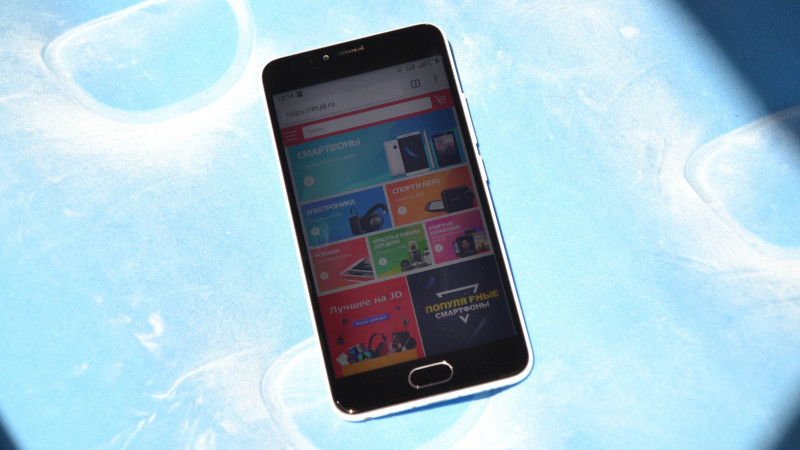
Further, a small disassembly to assess maintainability. Well, it doesn't hurt to look at the battery. First of all, you need to unscrew the two tiny screws at the bottom of the smartphone (about micro usb). Here you need a small star screwdriver. Next, insert a pick or a sharpened credit card between the lid and the screen and open the latches moving along the perimeter. The interior is covered with protective metal strips that cover cables and other fragile components. To access the battery, unscrew 3 screws from the protection (Fig. 1) and disconnect the ribbon cable (Fig. 2). 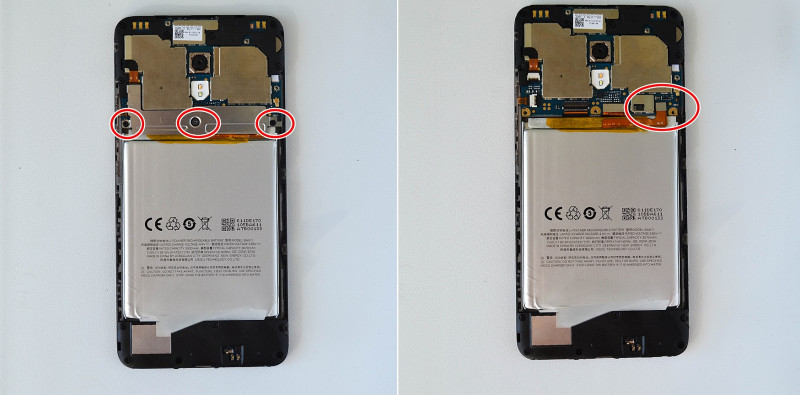
As you can see, you can replace the battery when it fails yourself. The BA611 battery, with a typical capacity of 3070 mAh (available 3000 mAh) or 11.55 Wh, is available separately. It looks like this 
There are loops under the battery, in the upper part you can continue disassembling, removing the protection - unscrew motherboard etc. It is clearly seen that there are really two LEDs for backlighting the photo and they have different color temperatures. 
If you are interested in a complete disassembly, then you can find one on YouTube. I will turn to the operation of the apparatus. I'll start right away with the good news. The smartphone has the global international firmware Flyme 5.2.10.1G. The firmware is not the latest, so it can be updated. Either through OTA, or if for some reason OTA does not see the update, then download latest firmware s, throw it on your smartphone at the root of the system. After that, go to the explorer, click on the firmware and click on update. In such a simple way, I put the extreme global 5.2.10.3G. Well, very soon the smartphone is promised an update to Flyme 6. 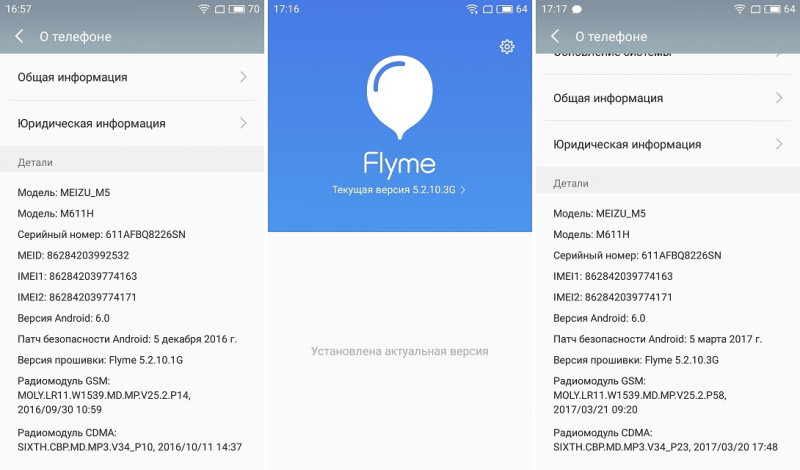
The Flyme shell is well known to Meizu users - simple, functional and beautiful. All applications are on the desktop, but folders can be created to be grouped by category. 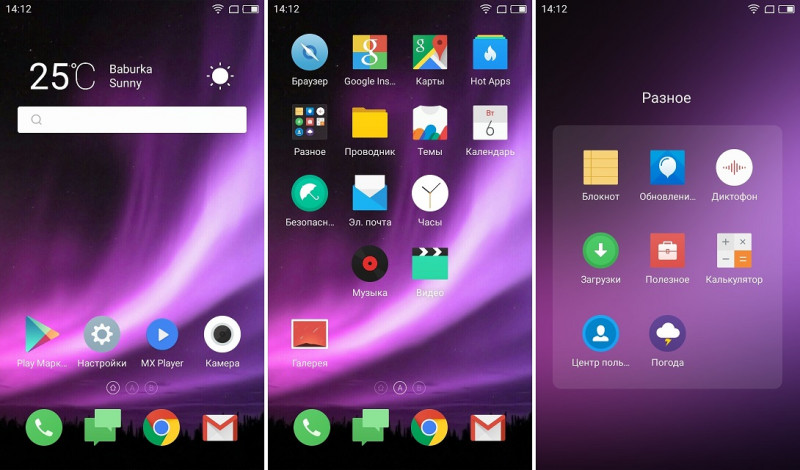
By swiping from the top, you can call up the quick access panel to the main functions, by swiping from the bottom, the taskbar is called up. V full settings smartphone can be accessed by clicking on the gear in the right upper corner... In general, the shell is intuitive and those who previously used pure Android or another shell, for example MIUI, will easily figure out all the features of Flyme. 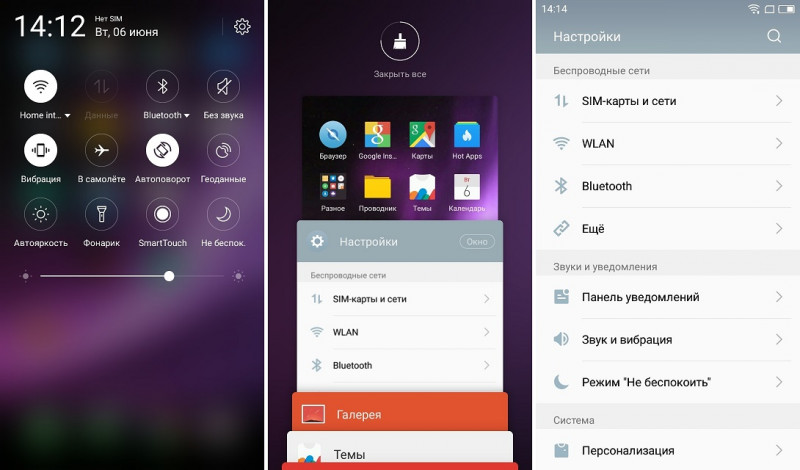
The smartphone has a simplified mode of use, when all applications, functions and settings are displayed in the form of large tiles, and the font is enlarged. This mode can be useful for elderly people who cannot master the small elements of the system, or vice versa - for children. 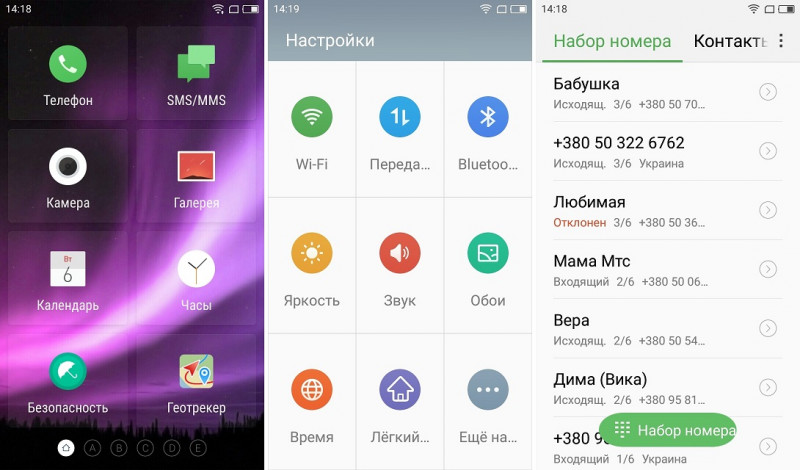
The firmware works stably, during testing there was not a single glitch, application crashes or freezes. A standard set of utilities is preinstalled, which can be found in the security application - here you can find antivirus, blacklist, and much more. And in the "Useful" application you can find a compass, level, flashlight, etc. To give personality there is an application - themes, where they are available for free for download. There you can also download wallpapers for your desktop. 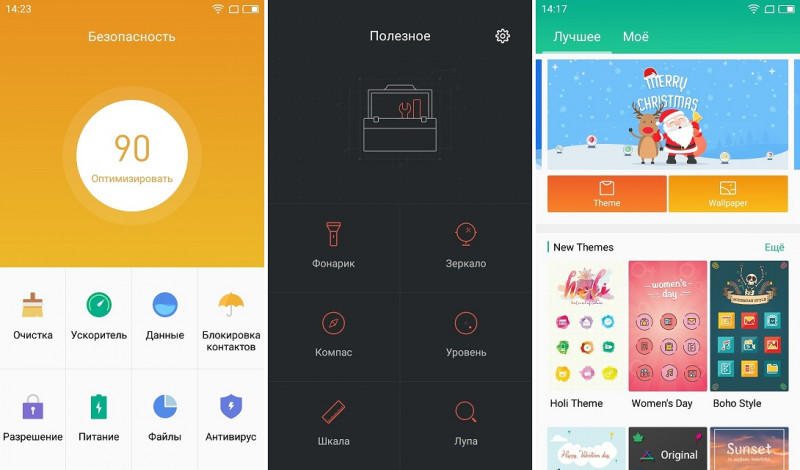
In terms of performance, the smartphone cannot boast of anything outstanding. There is enough hardware for the smooth operation of the system, web surfing and other daily tasks. Antutu - the result is about 40,000 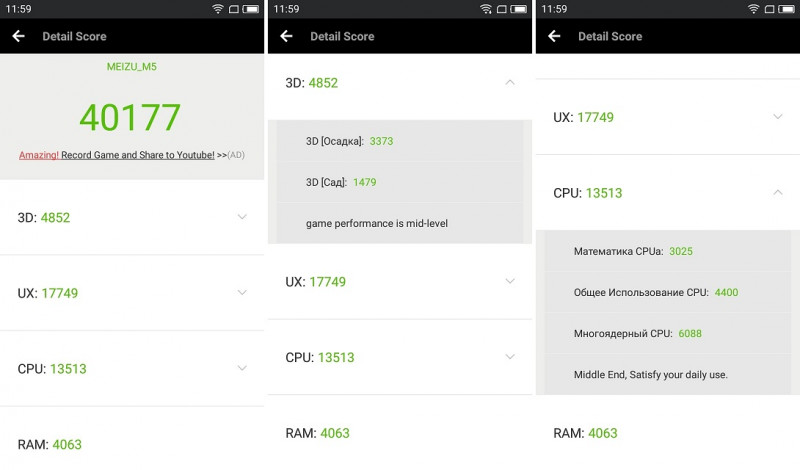
The smartphone is also suitable for games, mainly due to the low screen resolution - this reduces the load on the GPU and allows you to get a high FPS. In Epic Citadel at maximum graphics settings - 49 frames per second. Most games work fine on high graphics settings, only in especially demanding ones, the settings should be reduced to medium. 
In operation, the smartphone does not heat up even under intense loads, the body temperature in games does not exceed 36 - 37 degrees. The test for throttling using a non-stop running Epic Citadel showed its absence - the average fps value fluctuated within the margin of error.
Test results in other benchmarks:
- Geekbench 4 Single Core: 641
- Geekbench 4 Multi Core: 2202
- Geekbench RenderScript: 1541
- PC Mark Work 2.0: 3057
- Performance Test Mobile: System - 3260, CPU - 71120, Memory test - 4537, Disk Test - 28902, 2D graphics - 3130, 3D graphics - 698.
The test of the built-in storage showed a good speed for a smartphone: reading - 128 Mb / s, writing - 54 Mb / s. The RAM showed a copying speed of more than 4500 mb / s. 
Here I found another interesting benchmark for RAM, it is called RAM Benchmark. So, according to its results, the memory here is mediocre. True, and the comparison in the table is only with flagships, like: Iphone 7, Lenovo ZUK 2 or Xiaomi Mi5S. For fun, you can run a test on your smartphone and compare the results. I would be glad if you share your results in the comments. 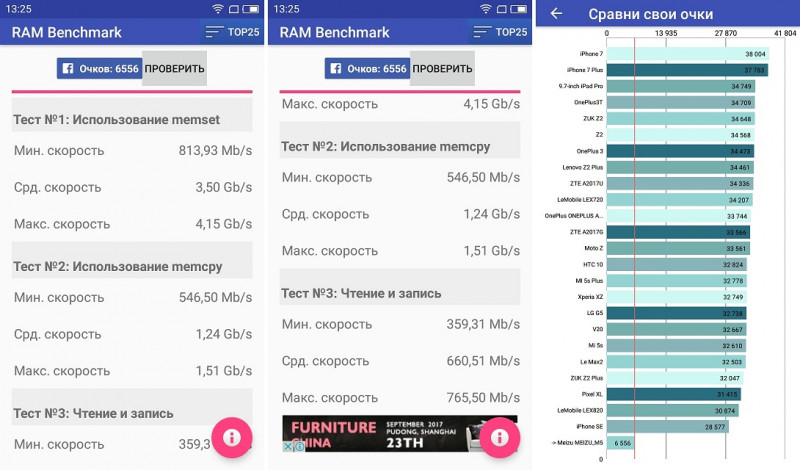
In terms of performance, the smartphone did not bring any unpleasant surprises. The call quality is quite normal, the earpiece is loud and clear. The Internet works correctly, switching between networks on time when the signal is weak. WiFi supports dual-band operation, which is very good for an entry-level smartphone. For example, Redmi 4X can only operate at 2.4 Ghz. In conditions of network "clutter" in apartment buildings, when several people sit on the same frequency, this can lead to a drop in download speed to 5-10 megabits. Well, even if you do not have many neighbors, and you live in a private house, the maximum that you will get is still about 50 Mbps. Meizu M5 also shows a speed of about 50 Mbps at 2.4 Ghz, but at 5 Ghz it is already twice as much and is about 100 Mbps. 
You can also use your smartphone as a navigator. Support for GLONASS satellites, fast connection (the first fixation time without the Internet is 3 seconds), stable and confident reception. 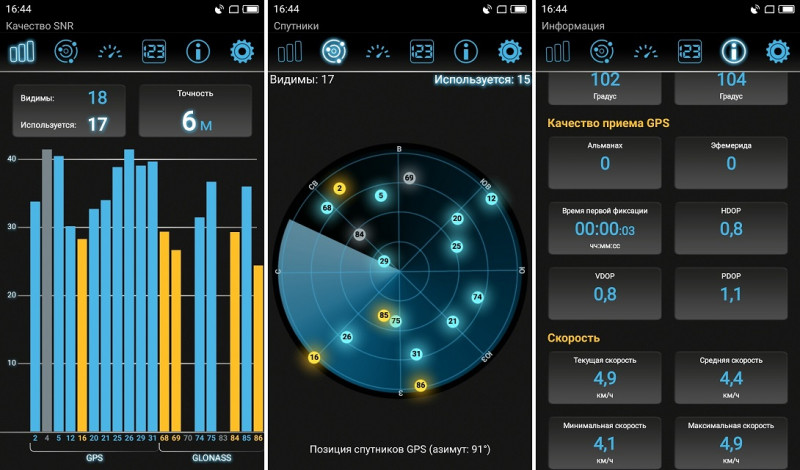
As for the camera, here the impression is ambiguous. If we consider the camera, comparing it with other smartphones, without being tied to the price, then it is rather mediocre. If you compare in the price range, about $ 100 - it is one of the best. It all depends on the requirements and expectations. But I can only say one thing - good pictures are obtained only with sufficient lighting. It's better not to reach it in the dark)) As well as any smartphone of this price category. But what I liked - phase detection autofocus. Meizu smartphones have always been famous for fast shooting, but in inexpensive models it is not often found. Instant focusing, fast serial - you may not notice how out of the blue while walking you snap a couple of hundred shots) For example, I always take 2 - 3 shots at once, because sometimes the focus misses or just a person can blink. And most of all, in cheap Chinese phones, the long refocusing is terribly infuriating, but here - "one hit one shot" :) Well, a couple of examples from everyday shots (you can see the originals): 



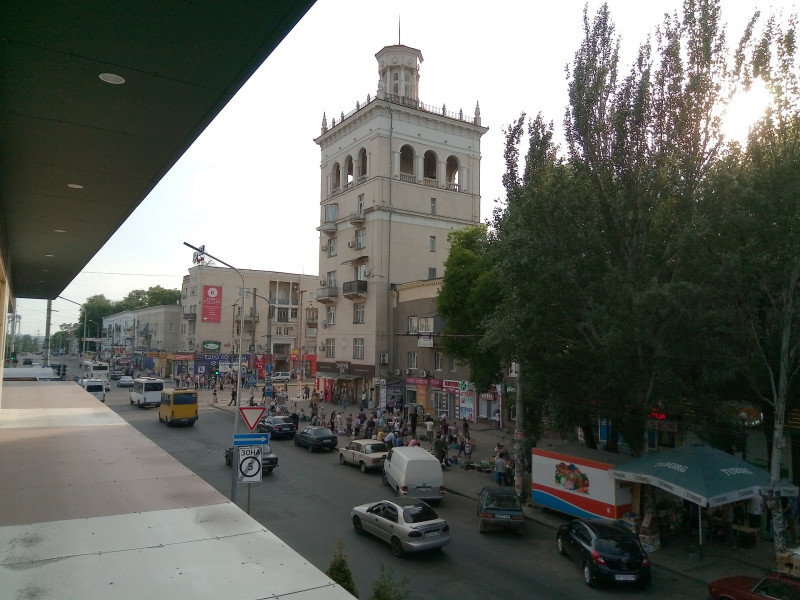
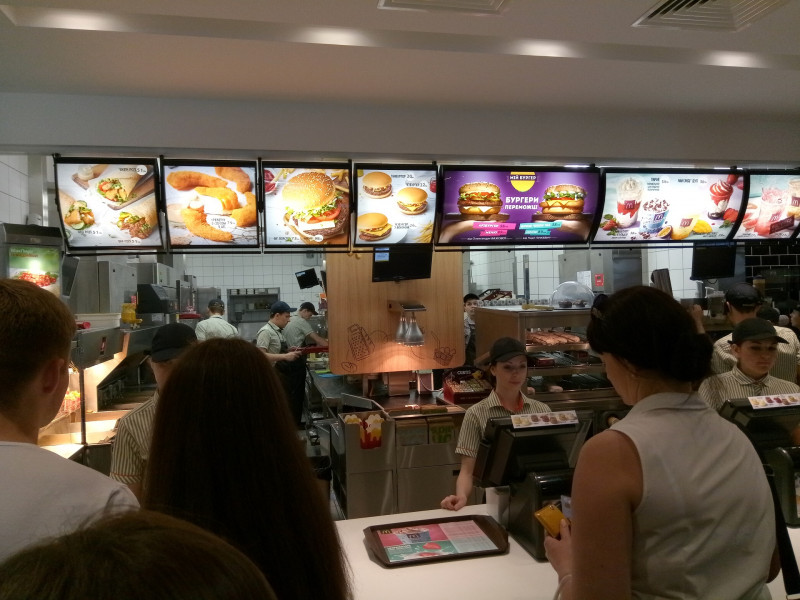

The video did not disappoint either - good detail at full hd resolution and 30 frames per second. MP4 format. You can see an example in the video review (at 16:20), which will be at the end of the article.
Regarding the battery, everything is extremely simple here. It is enough for a day of active use, by the evening there is still about 20% of the charge. This is if you actively use 3G and play a little. If used in a more gentle mode - 2 days. The declared capacity is 3000 mAh, through the tester, 2900 mAh was poured into the switched off smartphone. That is, either the actual capacity is slightly less than the declared one, or the smartphone turns off earlier than expected, saving battery life, preventing deep discharge. It is clear that the display meter, but you can get some idea. 
Traditional battery tests. Antutu Battery Tester at maximum screen brightness lasted 4 hours 44 minutes and scored 8225 points. 
The battery test in Geekbench 3 showed a result of 4520 points and 7 hours 32 minutes. 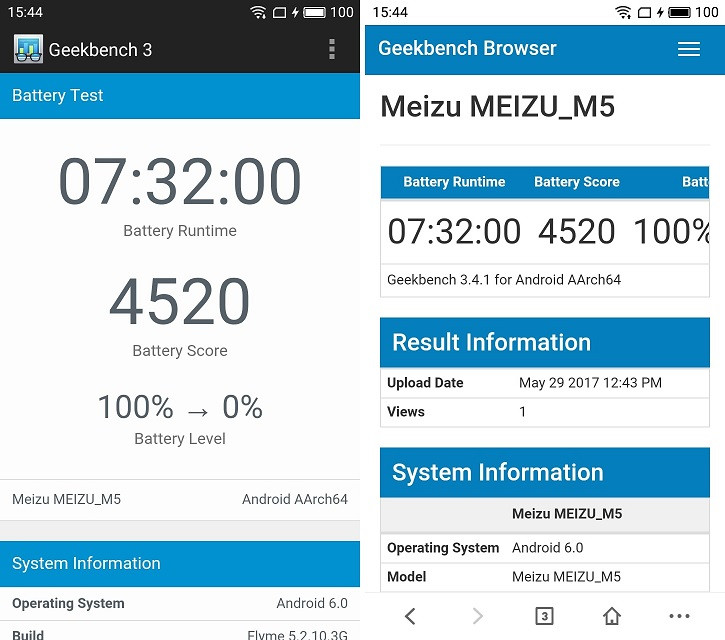
Simple yet effective test: HD video playback at maximum brightness - 7 hours 10 minutes. 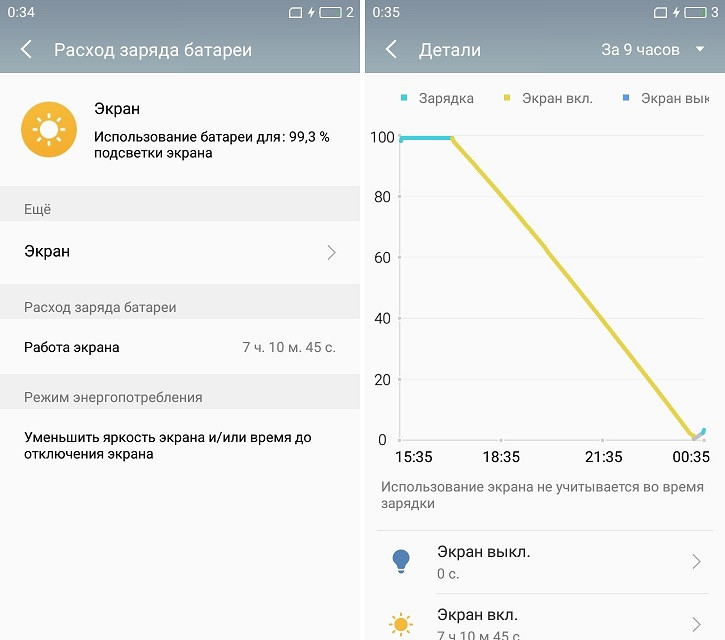
In gaming mode at maximum brightness, the smartphone worked for 3 hours and 40 minutes, music through headphones at maximum volume - almost 2 days.
So, in my opinion, the Meizu M5 smartphone is not much different from its predecessor M3S. In fact, we are offered a slightly modified version of it, under the guise of a new model. Slightly increased the diagonal, changed the materials and voila - a novelty :) Nevertheless, I consider the model to be successful and I can recommend it to those who are looking for an inexpensive, but stylish smartphone... As for the alternatives, I can suggest Redmi 4X, which is equipped with a more capacious battery, but does not support WiFi in the 5 Ghz range. Well, and the design, personally I am much nicer at Meizu (the face is almost a copy of my beloved Mi5S) 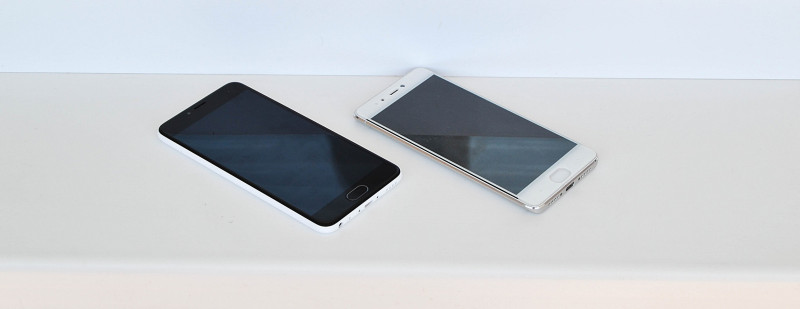
I also suggest watching the video version of the review.
The product is provided for writing a review by the store. The review is published in accordance with clause 18 of the Site Rules.
I plan to buy +18 Add to favourites I liked the review +60 +91The cheapest representative of the 2017 Meizu smartphone line fell into the hands of the Pixel Story editors - Meizu M5c... This budget device went on sale in Russia quite recently for a very affordable price - 8 990 rubles... This is the most demanded segment among Russians. Apparently, that's why Meizu decided to strengthen itself here as well.
What does it have to offer modern state employee from a well-known Chinese manufacturer? We tested the Meizu M5c and found out personally what is good and bad about the new product.
Meizu M5c specifications
- Display: 5 ″, IPS LCD, 1280x720 pixels (HD), contrast ratio 1000: 1, 294 ppi, full lamination
- Chipset: MediaTek MT6737, 4x ARM Cortex-A53 cores @ 1.3GHz
- RAM: 2 GB LPDDR3 type
- Built-in memory: 16 GB, microSD support up to 128 GB
- Main camera: 8 MP, 4-element lens, aperture f / 2.0, PDAF autofocus, dual flash
- Front camera: 5 MP, aperture f / 2.2, Face AE technology
- Communication: 4G LTE, 3G, GPS, A-GPS, GLONASS, Bluetooth 4.1, Wi-Fi 802.11 b / g / n
- Connectors and sensors: MicroUSB, 3.5 mm audio jack, light sensor, distance sensor, gyroscope, digital compass
- Battery: 3,000 mAh, non-removable
- Body material: polycarbonate
- Colors: black, gold, blue, red, pink
- Operating system: Android 6.0 Marshmallow with Flyme 6 shell
- Dimensions: 144x70.51x8.3 mm, weight - 135 g
Design and ergonomics
The appearance of Meizu M5c is a classic of Meizu style. Rectangular body with rounded edges, branded mBack button ( without a fingerprint scanner!) and a laconic back panel in various colors - everything is as expected from this manufacturer from the Middle Kingdom.


It's nice that Meizu design The M5c, despite the cheap materials, looks more expensive than its price - for this, a plus in the company's karma.
![]()

The main control keys are located on the right side of the smartphone. The power and volume buttons are positioned next to each other at a comfortable height - neither too low nor too high. The SIM and MicroSD card tray is on the left side of the case with a slot just above the middle.


The 3.5mm headphone jack is placed at the top. At the bottom you can find the MicroUSB connector as well as the perforation for the main speaker.

Pleased with the assembly of Meizu M5c - smartphone monolithically is assembled and fits comfortably in the hand thanks to the smooth shape of the back panel. The protective glass of the screen on the front, contrary to the trends, is devoid of 2.5D coating - the panel is completely flat and smooth. By the way, this does not spoil the general feeling of the device. Also I can not fail to note the excellent oleophobic coating- fingerprints are easily removed from glass.
The physical dimensions of the Meizu M5c are about the same in comparison with their counterparts. For example, the new product from Meizu is just a few millimeters higher than the Xiaomi Redmi 3 Pro. "Thank you" not to the thinnest side frames for this.


In general, Meizu M5c can be called a typical 5-inch smartphone without any special frills. Nice looking and great build. For 9 thousand rubles, this is not bad.
Screen
Meizu M5c has a 5-inch IPS display with HD resolution (1280x720 pixels) and full lamination.

The pixel density is 294 ppi, which is quite enough for an almost completely clear picture - with the usual distance from the eyes, you will definitely not notice obvious pixels. The number of simultaneous touches is 10.

There are no complaints about the quality of the displayed picture. HD resolution at 5 inches for balanced budget smartphone- the best solution. There are questions about color rendering. Since I had Xiaomi Redmi 3 Pro on my hands (a similar model both in price and in technical specifications from the main competitor Meizu), I decided to compare them with each other.
The color rendering on the Meizu M5c is clearly loses Xiaomi Redmi 3 Pro. Basic settings color balance strongly go into yellow shades, when the smartphone from Xiaomi has more natural and vibrant colors. It is worth noting that without direct comparison, you will not notice this - the picture looks great, but it is not. Due to this, the colors of the Meizu M5c are duller.

In any case, adjusting the color temperature of the screen is available in the "Screen and brightness" section in the system Meizu settings M5c. You can always customize colors for yourself, focusing on cold or, on the contrary, warm colors.
Black is not completely black at maximum brightness. This is due to the peculiarities of the IPS matrix, so there is no need to write it down as a minus. The white color is slightly yellow, the reason for this is already known to you.
At maximum brightness in cloudy weather without the sun, the screen is visible in sufficient detail. In direct sunlight, not only is nothing visible, but the glossiness of the front panel takes over all the reflection. The minimum brightness level is sufficient for working at night, the eyes do not strain.
The viewing angles of the Meizu M5c are almost maximum. With the strongest deviation, the picture loses its brightness, and the colors begin to distort slightly. Depending on the saturation of the gamut of the image, the distortions look different (violet, yellow or blue, for example).
The sensor response is good. When working with a smartphone, I did not notice any significant drawbacks in its speed. Unless with a light touch, the screen is not pressed. But, again, let's remember the cost of Meizu M5c and understand why there are such minor flaws here.
Cameras
Cameras are another place where the company has decided to make serious savings.

The Meizu M5c has an 8-megapixel module with f / 2.0 aperture, PDAF autofocus and Face AE face recognition technology for the main camera. For the front camera, a sensor with a resolution of 5 megapixels and an aperture of f / 2.2 is used - it will do for simple selfies and video conferencing. They are not entirely awful, but good or even good photosensors in the Meizu M5c cannot be called the language. For 9 thousand rubles, I expected a little more.

Basic settings include several modes:
- Manual
- Time-lapse
- Panorama
- QR Scanner
Video is recorded at a maximum resolution of 1280 × 720 (HD 720p) with an aspect ratio of 16: 9.
















Compared to Xiaomi Redmi 3 Pro, the new Meizu M5c demonstrates an obvious loss in detail and color reproduction. The most detailed and high-quality images are obtained during the day. With indoor artificial lighting, you can also make a good shot, but the output image brightness is lower than expected. Shooting at night is weak: there are strong noises, and there is no question of details at all. This, however, is not surprising as for a public sector camera.
 No correction
No correction
 Corrected by 5/5
Corrected by 5/5
The front module is good for its 5 megapixels. Photos are slightly blurry, but for simple selfies, it will do. The built-in smart correction mode with a scale from 1 to 5 will improve various little things: it will even out the color of the skin and eyes, smooth the face and even whiten the teeth. In general, the very thing for lovers of "perfect" selfies.
Software
Fresh Meizu M5c is powered by latest version company firmware - Flyme 6... Currently, its official release has not yet taken place, but Meizu pre-installs Flyme 6 on all new smartphones in 2017. The M5c is one of those.


There are no cardinal innovations in Flyme 6 as such. The company worked on stability and security, updated the software and slightly redesigned the shell. It cannot be said that it has become worse, but thick fonts in 2017 look somehow too outdated.
From the pre-installed applications in Flyme 6, standard Meizu services are available, as well as several third-party solutions and games. Among the latter: TouchPal keyboard, Yandex.Maps, Yandex.Music, Sberbank, Asphalt Nitro, Puzzle Pets, Real Football, Raging Squirrel and Spider-Man: Incredible Power. If desired, all this can be deleted and free up a small 16 GB of internal memory.


Flyme 6 works well and quickly on the Meizu M5c, although the hardware of this smartphone is not very powerful. Meizu has clearly worked hard on the new firmware. The impressions from the update are mostly positive.
Performance and runtime
At the heart of the Meizu M5c hardware platform is the well-known MediaTek processor MT6737 (64-bit architecture and four ARM Cortex-A53 cores @ 1.3 GHz). On the part of manufacturers, this is the most popular option today when choosing a cheap processor for a budget smartphone.


 The results of testing Meiu M5c in Epic Citadel
The results of testing Meiu M5c in Epic Citadel The video accelerator is the Mali-T720 MP1 solution with one core from the same ARM. Help the smartphone to work with 2 GB of RAM of the old type LPDDR3.
Meizu M5c handles classic everyday tasks perfectly. Calls, messages, social networks and watching videos - all this can be done on a smartphone all day long and without any performance issues. Despite not the most powerful processor, thanks to the optimization of Flyme 6, Meizu M5c works quite stably.

When testing benchmarks and working in games, special heating was noticed did not have... The upper part of the smartphone (where the processor is located) remains barely warm, without causing any discomfort in the hands. As for games, you can safely play typical arcade and casual games like Cut the Rope / Angry Birds / Hill Climb Racing / Alto’s Adventure or even simple races - like Asphalt Nitro.
Challenging 3D games at the level of Real Racing 3 / World of Tanks / Modern Combat 5 / Gta san Andreas Meizu M5c pulls, but, of course, without highly detailed graphics in them. Also, you will surely meet with frequent friezes and all sorts of slowdowns. And this is completely normal - there is neither a productive processor, nor a large amount of RAM to "eat" such heavy resources.
Autonomy
The new Meizu M5c received a battery capacity 3,000 mAh without support. Charging is carried out via the MicroUSB connector. The complete power adapter outputs 5 V at 1.5 A. I manually counted how long Meizu M5c takes to fully charge - from 0% to 100%, the smartphone charges for 2 hours 54 minutes.

In test mode (100% brightness, work in a Wi-Fi network, video looping and background notifications), the smartphone lasted 9 hours 5 minutes... Not the best, but not the worst result either. It's more than enough for the average user using a standard set of features throughout the day.
Communication and sound
Meizu M5c is equipped with two NanoSIM slots. Both connectors support 3G / 4G (LTE Cat. 6) networks in Russian frequencies: FDD-LTE / TD-LTE / TD-SCDMA / WCDMA / GSM.
Types of M5c networks:
- 4G FDD-LTE: B1 / 3/5/7/8/20
- 4G TD-LTE: B38 / 40
- 3G WCDMA: B1 / 2/5/8
- 2G GSM: B2 / 3/5/8
I tested Meizu M5c in Voronezh. At permanent work network, the smartphone gave me a stable H + (3.5G) connection with all five antenna indicator sticks or 4G (LTE) for 4-5 sticks. It happens that the connection on the Meizu M5c is abruptly cut off and the indicator shows 1-2 sticks, but this happens literally within a few seconds and does not affect the connection speed in any way.
Sites on mobile communications are loaded quickly. Even heavy pages are fully loaded in a fairly short time. 4G support is clearly beneficial here.
The earpiece installed in Meizu M5c has a decent sound quality. When talking with the interlocutor, I hear him well, loudly and without noise. From the side of the interlocutor himself, everything is the same - the sound without any special distortions.
Sound
The main speaker of the Meizu M5c sounds worse than I thought. When I turned it on for the first time, I was surprised by the sound quality of the smartphone - poor sound quality, as if a poorly tuned equalizer (by the way, you cannot configure it out of the box). At full volume, the sound is not only very flat but also too noisy. Not all details of the sound track are heard. It is definitely impossible to listen to rock on the Meizu M5c - I am sure that true connoisseurs of this genre will definitely not like this sound.
In headphones, things are better. The sound quality in the headset is on par with the older Meilan models. Simply put, your ears will not bleed.

In terms of volume, the last budget employee Meizu not the worst in the class. In any case, louder than Xiaomi Redmi 3 Pro, and an order of magnitude louder. Normal level for its price. Covering the speaker, the volume drops almost completely - by about 90% (if suddenly anyone is interested).
Competitors
At the time of the review, the official price of Meizu M5c in Russia is 8,990 rubles. For the same money, more interesting smartphones offered by other manufacturers, including Chinese ones.
The main competitors of Meizu M5c:
- - 9 990 rubles
- Xiaomi Redmi 4A- 8 990 rubles
- Lenovo K5- 8 990 rubles
- Neffos c5 max- 8 990 rubles
- Fly Cirrus 13- 8 990 rubles
- Alcatel Shine Lite- 7 990 rubles at a discount (8 990 rubles without a discount)
Meizu M5c review. Conclusion
Meizu M5c - good state employee... It's beautiful, well-built and works great thanks to Flyme 6. The affordable price tag makes it a worthy proposition in today's cheap smartphones market.

First of all, Meizu M5c is ideal for the most simple and undemanding user - a girl or a child.
Pros:
- Nice design
- Monolithic assembly
- Excellent oleophobic coating
- Flyme 6 out of the box
- Decent autonomy
Minuses:
- Mediocre camera
- No fingerprint scanner
- Flat safety glass














